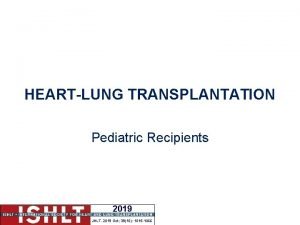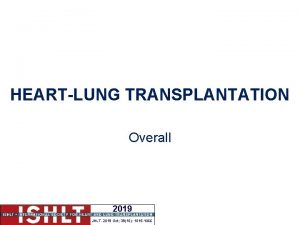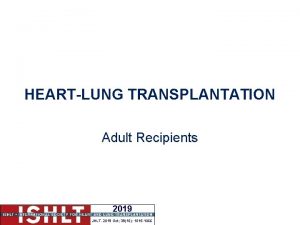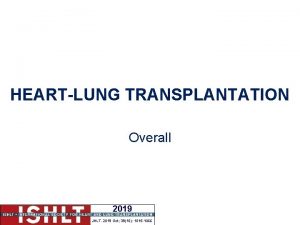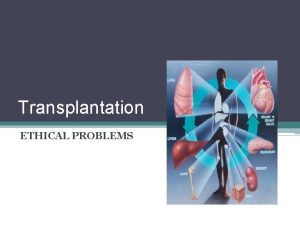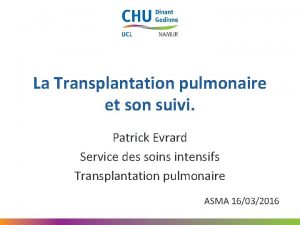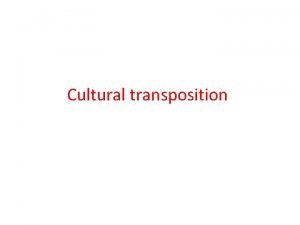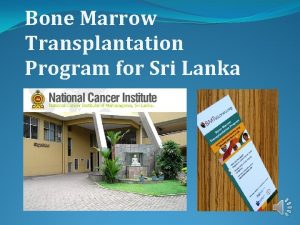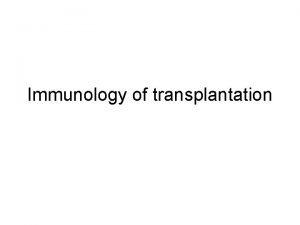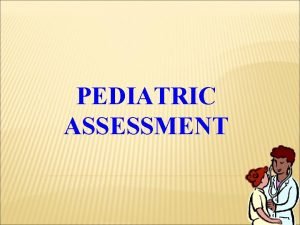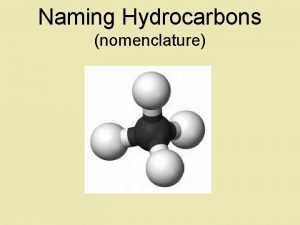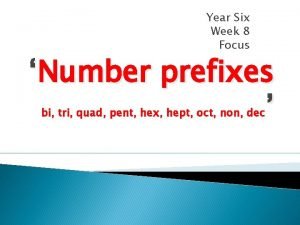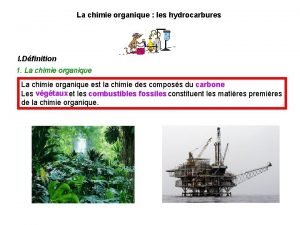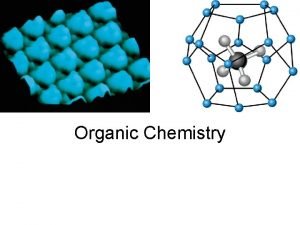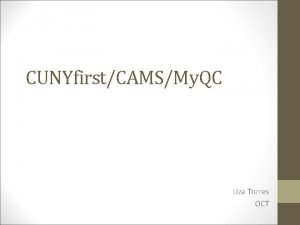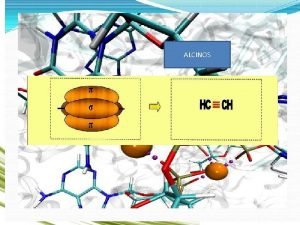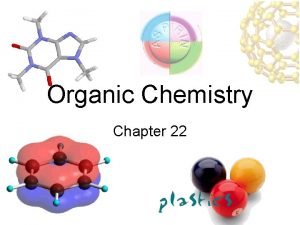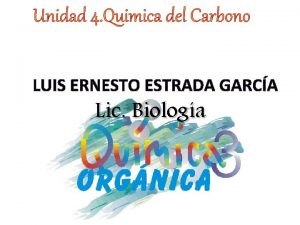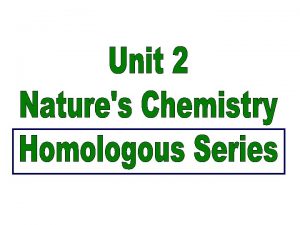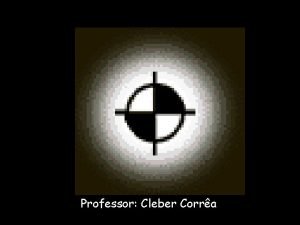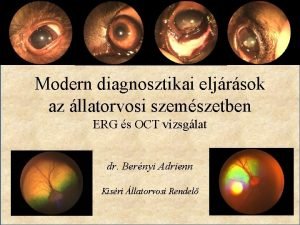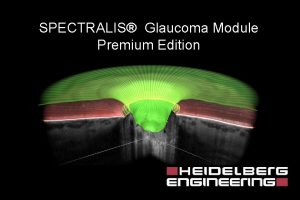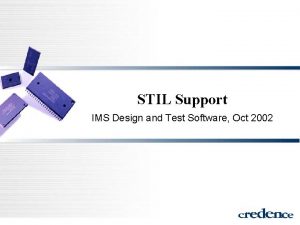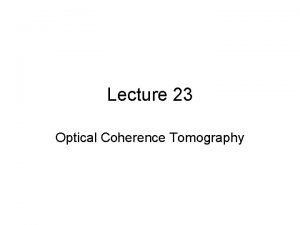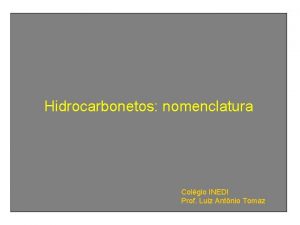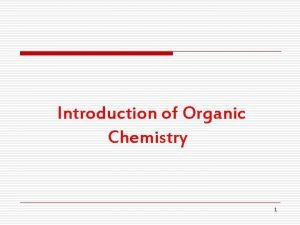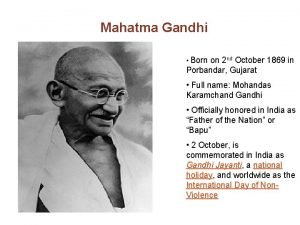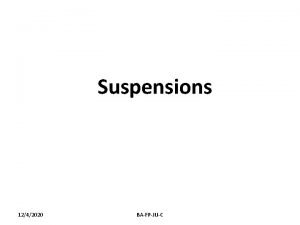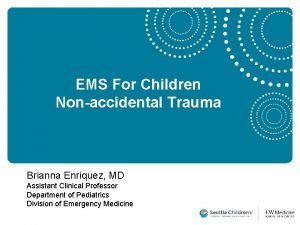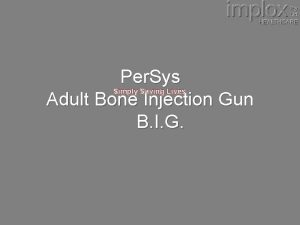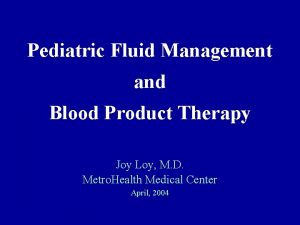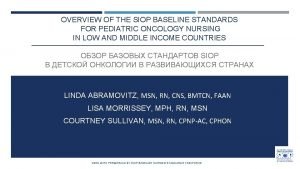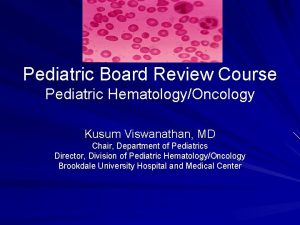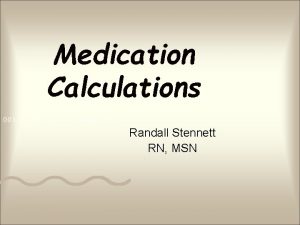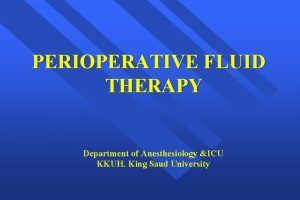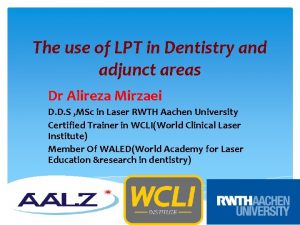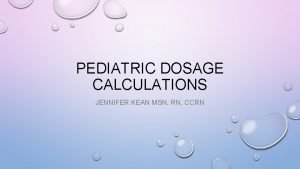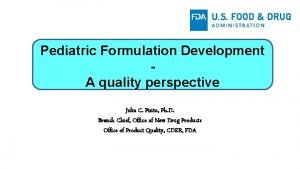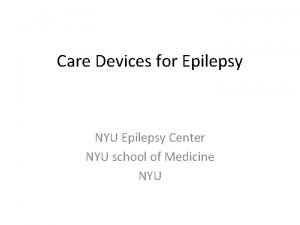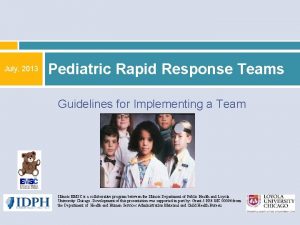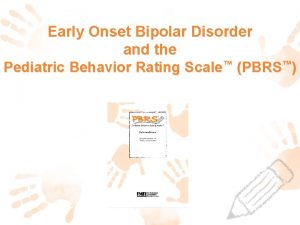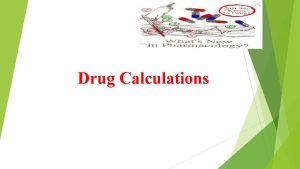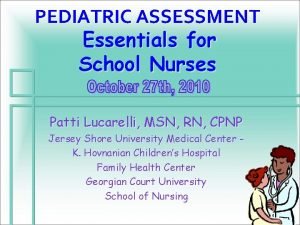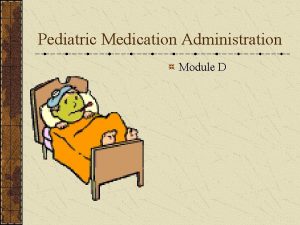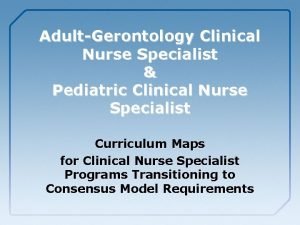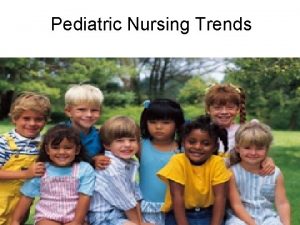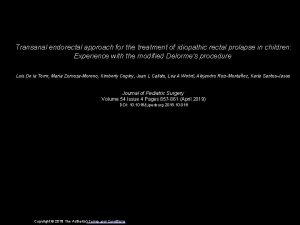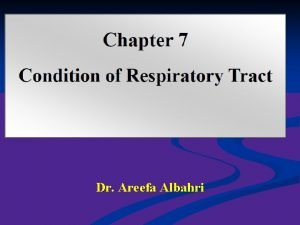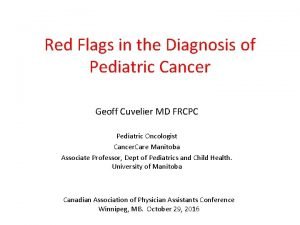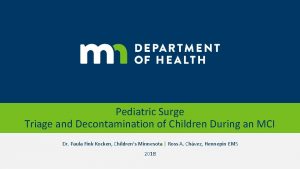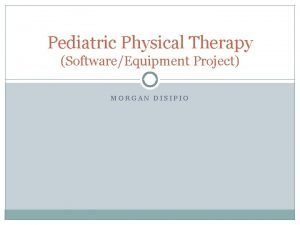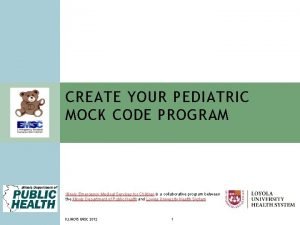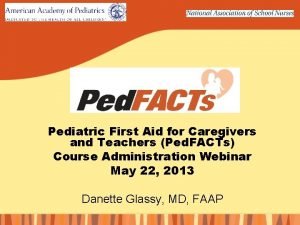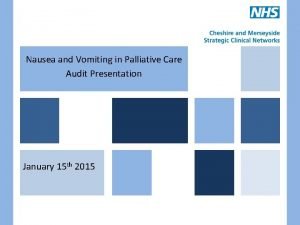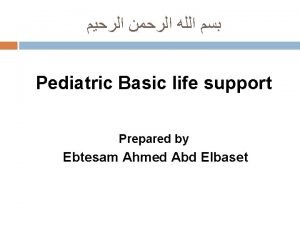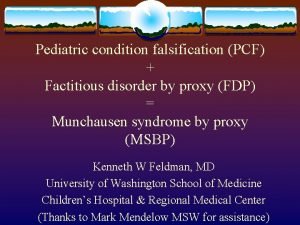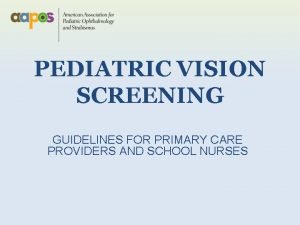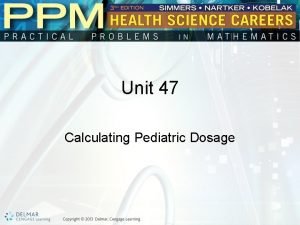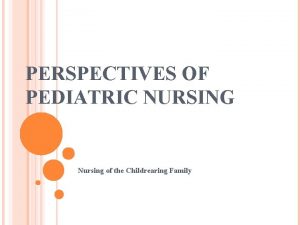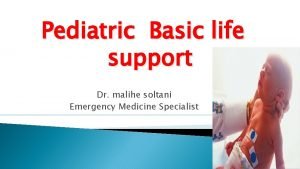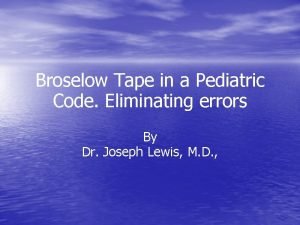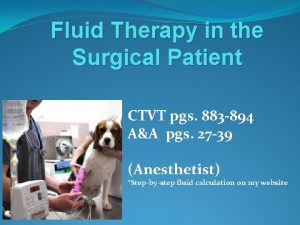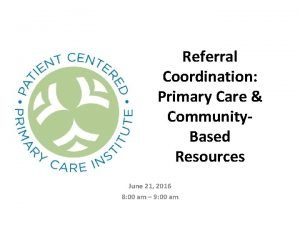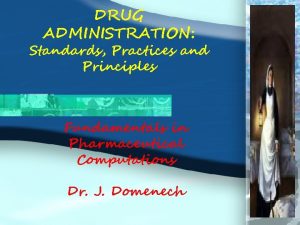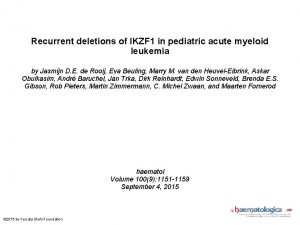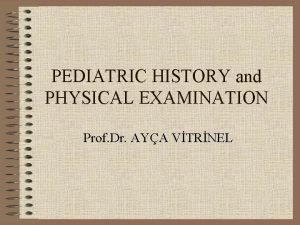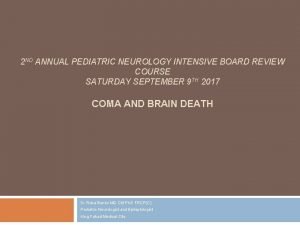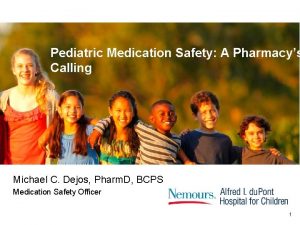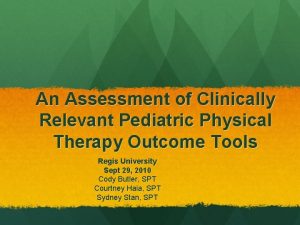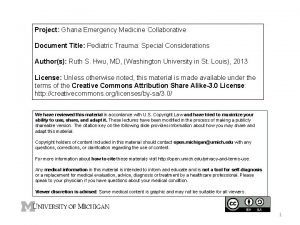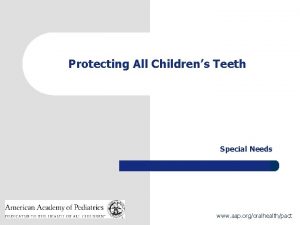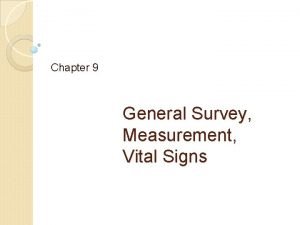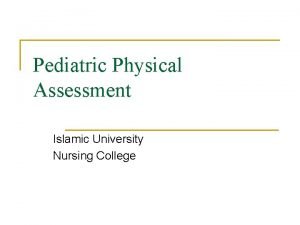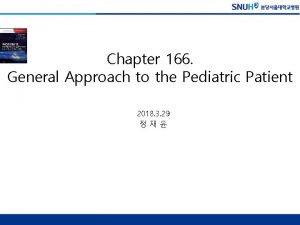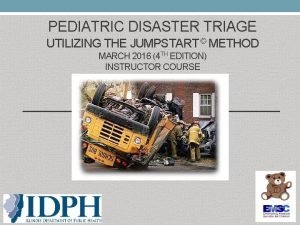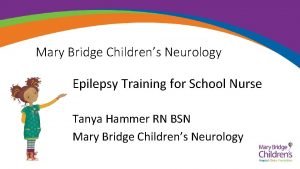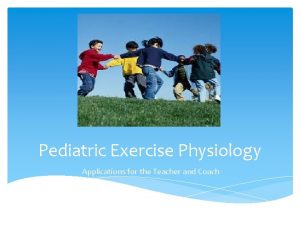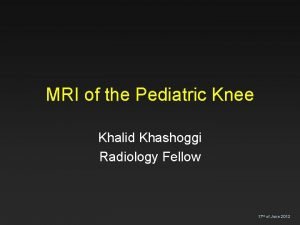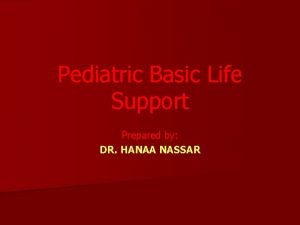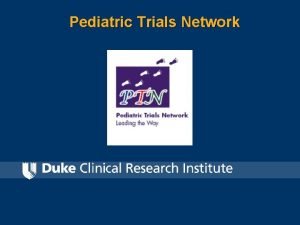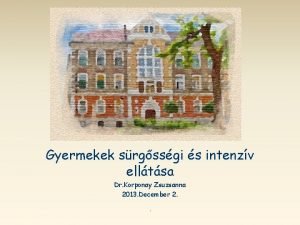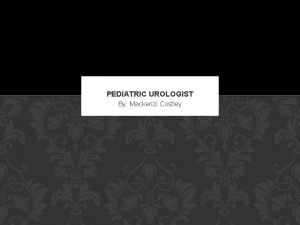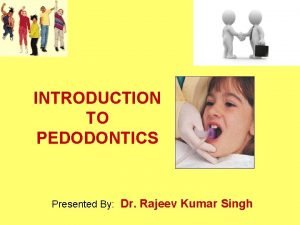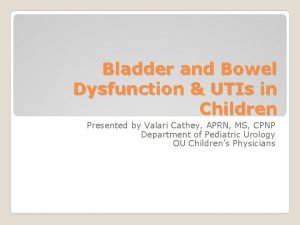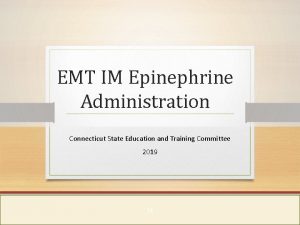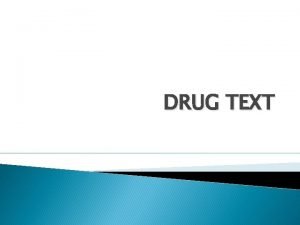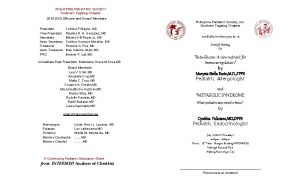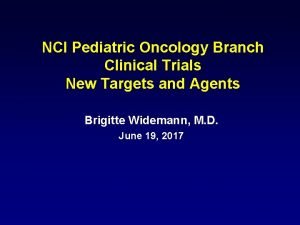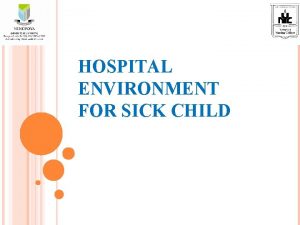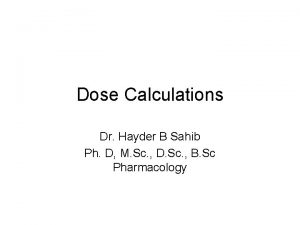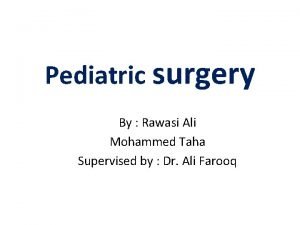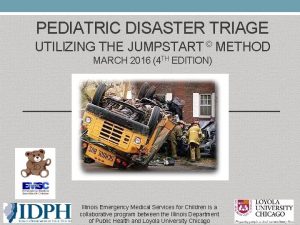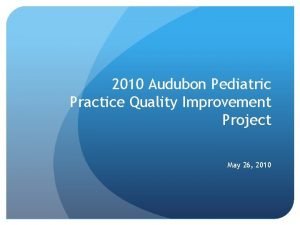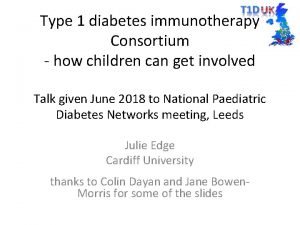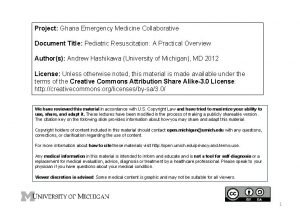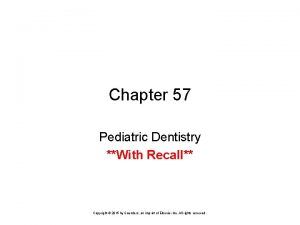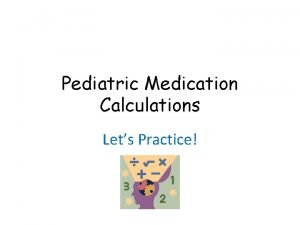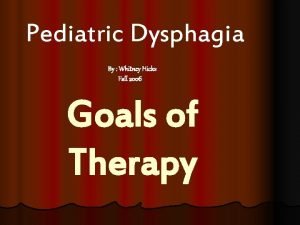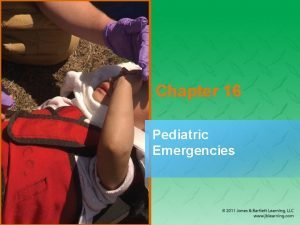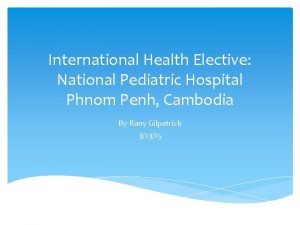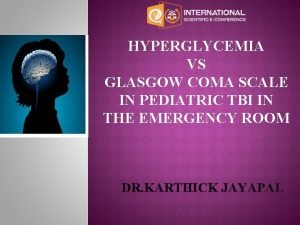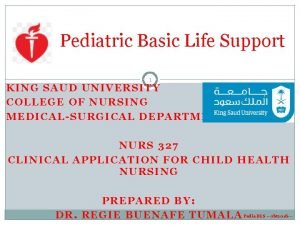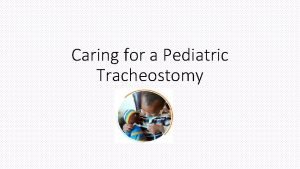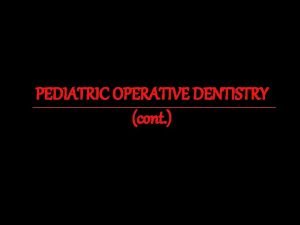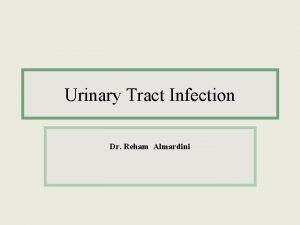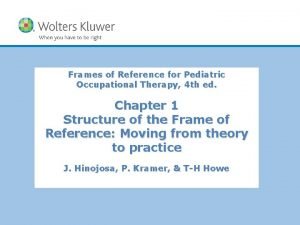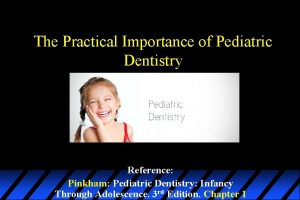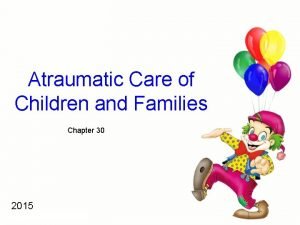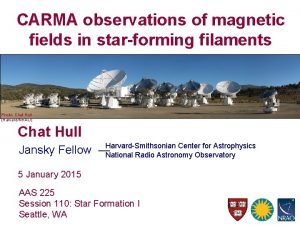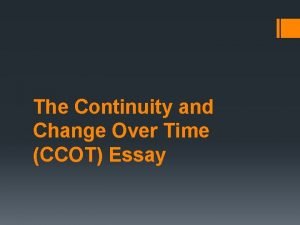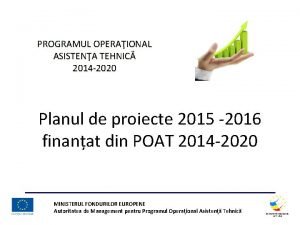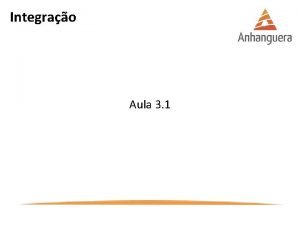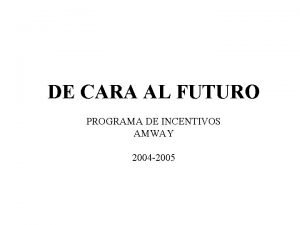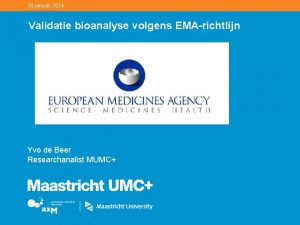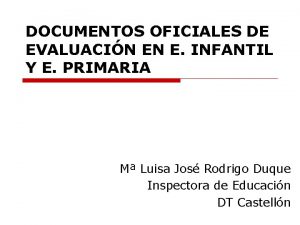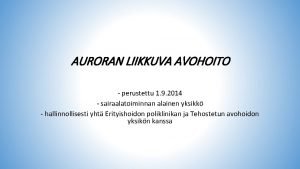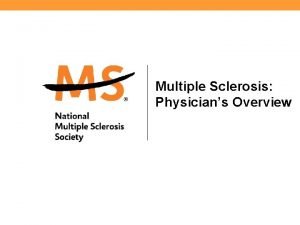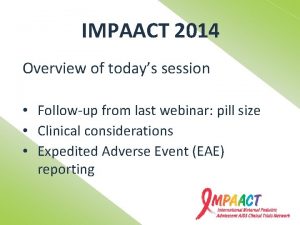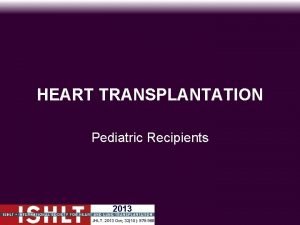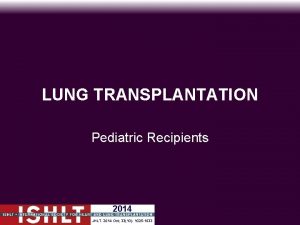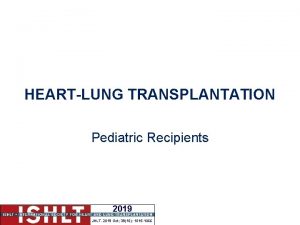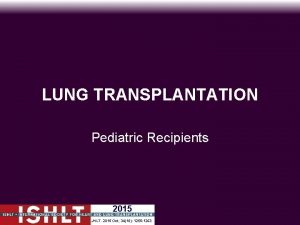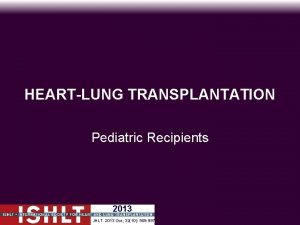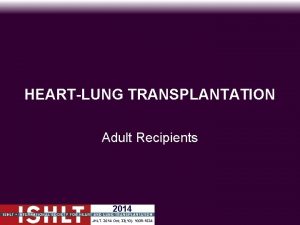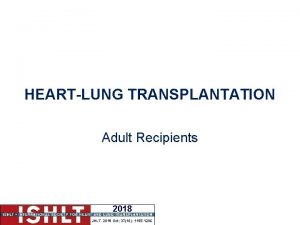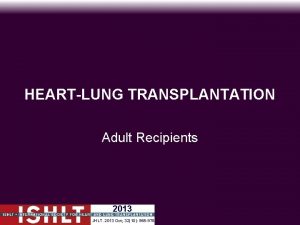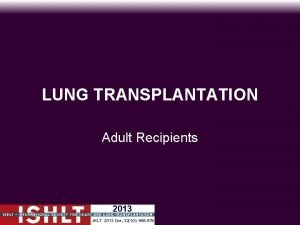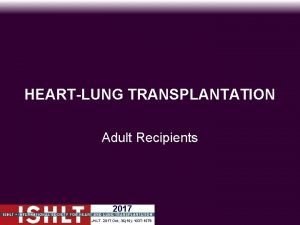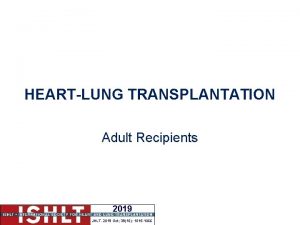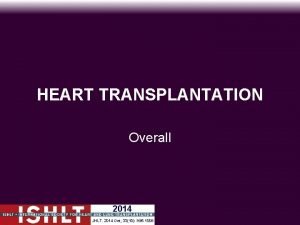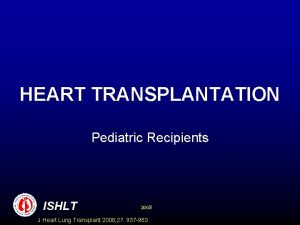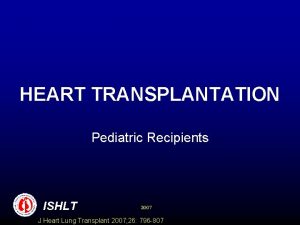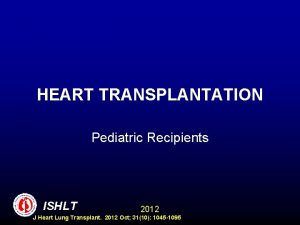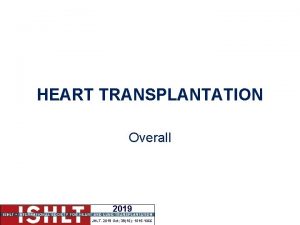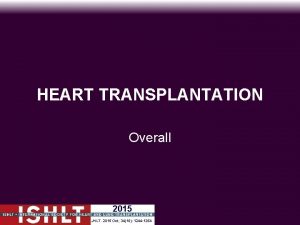HEART TRANSPLANTATION Pediatric Recipients 2014 JHLT 2014 Oct





















































































































































































- Slides: 181

HEART TRANSPLANTATION Pediatric Recipients 2014 JHLT. 2014 Oct; 33(10): 985 -995

Table of Contents < Donor, recipient and center characteristics: slides 3 -25 < Post transplant – survival and other outcomes: slides 2646 < Induction and maintenance immunosuppression: slides 47 -61 < Rejection and post transplant morbidities: slides 62 -98 < Multivariable analyses: slides 99 -163 and 177 -181 < Retransplantation: slides 164 -181 2014 JHLT. 2014 Oct; 33(10): 985 -995

Donor, Recipient and Center Characteristics 2014 JHLT. 2014 Oct; 33(10): 985 -995

Pediatric Heart Transplants Number of Centers Reporting Transplants 120 110 90 North America Europe 80 70 60 50 40 30 20 10 0 19 1982 1983 1984 1985 1986 1987 1988 1989 1990 1991 1992 1993 1994 1995 1996 1997 1998 2099 2000 2001 2002 2003 2004 2005 2006 2007 2008 2009 2010 2011 12 Number of Centers 100 Other Transplant Year 2014 JHLT. 2014 Oct; 33(10): 985 -995

Pediatric Heart Transplants Number of Centers by Center Volume (Transplants: January 2000 – June 2013) 160 Number of Centers 140 2000 -2005 120 2006 -June 2013 100 80 150 137 60 40 20 23 17 0 1 -4 5 -9 Average number of heart transplants per year 2014 JHLT. 2014 Oct; 33(10): 985 -995 21 14 10+

Pediatric Heart Transplants Distribution of Transplants by Center Volume (Transplants: January 2000 – June 2013) 60 2000 -2005 2006 -June 2013 % of Transplants 50 40 30 20 50. 7 40 34. 6 25. 4 10 25. 4 23. 9 0 1 -4 5 -9 Average number of heart transplants per year 2014 JHLT. 2014 Oct; 33(10): 985 -995 10+

Pediatric Heart Transplants Recipient Age Distribution by Center Volume (Transplants: January 2000 – June 2013) <1 1 -5 6 -10 11 -17 100% % of Transplants 80% 60% 40% 20% 0% 1 -4 5 -9 Average number of heart transplants per year 2014 JHLT. 2014 Oct; 33(10): 985 -995 10+

Pediatric Heart Transplants Distribution of Transplants by Location and Average Center Volume (Transplants: January 2000 – June 2013) 1 -4/year 5 -9/year 10+/year % of Transplants 100% 80% 60% 40% 20% 0% Europe North America 2014 JHLT. 2014 Oct; 33(10): 985 -995 Other

Pediatric Heart Transplants Recipient Age Distribution (Transplants: January 2000 – June 2013) 1, 800 Number of Transplants 1, 600 1, 400 1, 200 1, 000 800 600 400 200 0 <1 1 2 3 4 5 6 7 8 9 10 11 Recipient Age (Years) 2014 JHLT. 2014 Oct; 33(10): 985 -995 12 13 14 15 16 17

Pediatric Heart Transplants 650 600 550 500 450 400 350 300 250 200 150 100 50 0 11 -17 Years 6 -10 Years 1 -5 Years <1 Year 19 1982 1983 1984 1985 1986 1987 1988 1989 1990 1991 1992 1993 1994 1995 1996 1997 1998 2099 2000 2001 2002 2003 2004 2005 2006 2007 2008 2009 2010 2011 12 Number of Transplants Recipient Age Distribution by Year of Transplant 2014 JHLT. 2014 Oct; 33(10): 985 -995 NOTE: This figure includes only the heart transplants that are reported to the ISHLT Transplant Registry. As such, this should not be construed as evidence that the number of hearts transplanted worldwide has increased and/or decreased in recent years.

Pediatric Heart Transplants Recipient Age Distribution by Location (Transplants: January 2000 – June 2013) <1 years 1 -5 years 6 -10 years 11 -17 years % of Transplants 100% 80% 60% 40% 20% 0% Europe North America 2014 JHLT. 2014 Oct; 33(10): 985 -995 Other

Pediatric Heart Transplants Donor Age Distribution (Transplants: January 2000 – June 2013) Number of Transplants 1, 200 1, 000 800 600 400 200 0 <1 1 2 3 4 5 6 7 8 9 10 11 12 13 14 15 16 1718 -25 26 -3031+ Donor Age (Years) 2014 JHLT. 2014 Oct; 33(10): 985 -995

Pediatric Heart Transplants Donor and Recipient Age (Transplants: January 2000 – June 2013) Recipient Age: <1 1 -5 6 -10 11 -17 100% % of Transplants 80% 60% 40% 20% 0% <1 1 -10 11 -17 18 -34 Donor Age 2014 JHLT. 2014 Oct; 33(10): 985 -995 35 -49 50 -65

Pediatric Heart Transplants Donor Age Distribution by Location (Transplants: January 2000 – June 2013) <1 1 -10 11 -17 18 -34 35 -49 50 -65 % of Transplants 100% 80% 60% 40% 20% 0% Europe North America 2014 JHLT. 2014 Oct; 33(10): 985 -995 Other

Pediatric Heart Transplants Distribution of Transplants by Donor/Recipient Weight Ratio (Transplants: January 2000 – June 2013) 50 45 2000 -2005 2006 -June 2013 % of Transplants 40 35 30 25 20 15 10 5 0 <0. 75 -<1. 0 -<1. 5 -<2. 0 -<2. 5 Donor/Recipient Weight Ratio 2014 JHLT. 2014 Oct; 33(10): 985 -995 2. 5+

Pediatric Heart Transplants Recipient Diagnosis (Age: < 1 Year) 41% 35% Myopathy 21% 0. 3% 1% 2% Congenital 3% 76% 62% 55% Other Re. TX 1988 -1999 2000 -2005 2006 -6/2013 Myopathy 75 Congenital 50 25 0 19 86 19 87 19 88 19 89 19 90 19 91 19 92 19 93 19 94 19 95 19 96 19 97 19 98 19 99 20 00 20 01 20 02 20 03 20 04 20 05 20 06 20 07 20 08 20 09 20 10 20 11 20 12 % of Cases 100 2014 For some retransplants diagnosis other than retransplant is reported, so the total percentage of retransplants may JHLT. 2014 Oct; 33(10): 985 -995 be greater.

Pediatric Heart Transplants Recipient Diagnosis (Age: 1 -5 Years) 53% 54% 56% 3% 2% 3% 1% 42% 1988 -1999 40% 2000 -2005 Myopathy 3% Congenital 2% Other 40% Re. TX 2006 -6/2013 Myopathy 75 Congenital 50 25 0 19 86 19 87 19 88 19 89 19 90 19 91 19 92 19 93 19 94 19 95 19 96 19 97 19 98 19 99 20 00 20 01 20 02 20 03 20 04 20 05 20 06 20 07 20 08 20 09 20 10 20 11 20 12 % of Cases 100 2014 For some retransplants diagnosis other than retransplant is reported, so the total percentage of retransplants may JHLT. 2014 Oct; 33(10): 985 -995 be greater.

Pediatric Heart Transplants Recipient Diagnosis (Age: 6 -10 Years) 56% 59% 54% Myopathy Congenital 7% 8% 8% 2% 35% 1988 -1999 Other 3% 34% 2000 -2005 2% 32% Re. TX 2006 -6/2013 Myopathy 75 Congenital 50 25 0 19 86 19 87 19 88 19 89 19 90 19 91 19 92 19 93 19 94 19 95 19 96 19 97 19 98 19 99 20 00 20 01 20 02 20 03 20 04 20 05 20 06 20 07 20 08 20 09 20 10 20 11 20 12 % of Cases 100 2014 For some retransplants diagnosis other than retransplant is reported, so the total percentage of retransplants may JHLT. 2014 Oct; 33(10): 985 -995 be greater.

Pediatric Heart Transplants Recipient Diagnosis (Age: 11 -17 Years) 66% 67% 66% Congenital 9% 3% 2% 8% 28% 1988 -1999 Myopathy Other 2% 2% 23% 24% 2000 -2005 Re. TX 2006 -6/2013 Myopathy 75 Congenital 50 25 0 19 86 19 87 19 88 19 89 19 90 19 91 19 92 19 93 19 94 19 95 19 96 19 97 19 98 19 99 20 00 20 01 20 02 20 03 20 04 20 05 20 06 20 07 20 08 20 09 20 10 20 11 20 12 % of Cases 100 2014 For some retransplants diagnosis other than retransplant is reported, so the total percentage of retransplants may JHLT. 2014 Oct; 33(10): 985 -995 be greater.

Pediatric Heart Transplants Diagnosis Distribution by Location (Transplants: January 2000 – June 2013) 100% Other % of Transplants 80% Re-TX/Graft Failure 60% Malignancy 40% Coronary Artery Disease Congenital Cardiomyopathy 20% 0% Europe North America 2014 Other For some retransplants diagnosis other than retransplant is reported, so the total percentage of retransplants may JHLT. 2014 Oct; 33(10): 985 -995 be greater.

Pediatric Heart Transplants % of Patients Bridged with Mechanical Circulatory Support* by Year (Transplants: January 2005 – December 2012) 35 ECMO 29. 1 VAD + ECMO 30 VAD or TAH % of Patients 25 22. 1 21. 1 22. 7 22. 0 2007 2008 28. 8 25. 2 25. 7 2010 2011 20 15 10 5 0 2005 2006 2014 JHLT. 2014 Oct; 33(10): 985 -995 2009 2012 * LVAD, RVAD, TAH, ECMO

Pediatric Heart Transplants % of Patients Bridged with Mechanical Circulatory Support* (Transplants: July 2004 – June 2013) 35 30 25. 3 % of Patients 25 20 15 11. 8 10 6. 2 5. 3 5 1. 3 0 Any Device LVAD (N=826) (N=384) ECMO (N=204) BIVAD (N=174) VAD+ECMO (N=42) 2014 JHLT. 2014 Oct; 33(10): 985 -995 0. 3 0. 2 RVAD (N=11) TAH (N=6) 0. 1 0. 0 Unknown ECMO + Type TAH (N=1) (VAD or TAH) (N=4) * LVAD, RVAD, TAH, ECMO

Pediatric Heart Transplants % of Patients Bridged with Mechanical Circulatory Support* by Age Group (Transplants: July 2004 – June 2013) 35 ECMO VAD + ECMO 30 VAD or TAH 27. 1 26. 9 26. 3 1 -5 6 -10 11 -17 % of Patients 25 21. 7 20 15 10 5 0 <1 Age Group 2014 JHLT. 2014 Oct; 33(10): 985 -995 * LVAD, RVAD, TAH, ECMO

Pediatric Heart Transplants PRA Distribution by Year (Transplants: January 2005 – December 2012) 0 -9% 10 -39% 40 -79% 80%+ 100% % of Patients 80% 60% 40% 20% 0% 2005 2006 2007 2008 2014 JHLT. 2014 Oct; 33(10): 985 -995 2009 2010 2011 2012 If Class I and Class II values were reported separately, the higher of the two values was used.

Pediatric Heart Transplants PRA Distribution by Age Group (Transplants: July 2004 – June 2013) 0 -9% 10 -39% 40 -79% 80%+ 100% % of Patients 80% 60% 40% 20% 0% <1 1 -5 6 -10 Age Group 2014 JHLT. 2014 Oct; 33(10): 985 -995 11 -17 p<0. 0001 If Class I and Class II values were reported separately, the higher of the two values was used.

Post Transplant: Survival and Other Outcomes 2014 JHLT. 2014 Oct; 33(10): 985 -995

Pediatric Heart Transplants Kaplan-Meier Survival (Transplants: January 1982 – June 2012) 100 <1 Year (N = 2, 702) 1 -5 Years (N = 2, 419) 6 -10 Years (N = 1, 552) 80 Survival (%) 11 -17 Years (N = 4, 219) Overall (N = 10, 892) 60 1 -5 vs. 11 -17: p = 0. 0133 6 -10 vs. 11 -17: p = 0. 0298 No other pair-wise comparisons were significant at p < 0. 05. 40 20 Median survival (years): <1=20. 6; 1 -5=17. 3; 6 -10=14. 6; 11 - 0 0 1 2 3 4 5 6 7 8 9 10 11 12 13 14 15 16 17 18 19 20 21 22 Years 2014 JHLT. 2014 Oct; 33(10): 985 -995

Pediatric Heart Transplants Kaplan-Meier Survival Conditional on Survival to 1 Year (Transplants: January 1982 – June 2012) 100 Median survival (years): <1 = NA; 1 -5 = 21. 5; 6 -10 = 16. 7; 11 -17 = 16. 1 Survival (%) 80 60 All pair-wise comparisons were significant at p < 0. 05 except <1 vs. 1 -5. 40 20 <1 Year (N = 1, 932) 1 -5 Years (N = 1, 876) 6 -10 Years (N = 1, 270) 11 -17 Years (N = 3, 401) Overall (N = 8, 479) 0 0 1 2 3 4 5 6 7 8 9 10 11 12 13 14 15 16 17 18 19 20 21 22 Years 2014 JHLT. 2014 Oct; 33(10): 985 -995

Pediatric Heart Transplants Kaplan-Meier Survival Conditional on Survival to 5 Years (Transplants: January 1982 – June 2008) 100 Survival (%) 80 60 All pair-wise comparisons were significant at p < 0. 05 except 6 -10 vs. 11 -17. 40 20 <1 Year (N = 1, 151) 1 -5 Years (N = 1, 167) 6 -10 Years (N = 790) 11 -17 Years (N = 1, 989) Overall (N = 5, 097) 0 0 1 2 3 4 5 6 7 8 9 10 11 12 13 14 15 16 17 18 19 20 21 22 Years 2014 JHLT. 2014 Oct; 33(10): 985 -995

Pediatric Heart Transplants Kaplan-Meier Survival Conditional on Survival to 10 Years (Transplants: January 1982 – June 2003) 100 Survival (%) 80 All pair-wise comparisons with <1 were significant at p<0. 0001. 1 -5 vs. 6 -10 was significant at p<0. 05 (p=0. 0199). No other pair-wise comparisons were significant at p<0. 05. 60 40 20 <1 Year (N = 648) 1 -5 Years (N = 587) 6 -10 Years (N = 375) 11 -17 Years (N = 927) Overall (N = 2, 537) 0 0 1 2 3 4 5 6 7 8 9 10 11 12 13 14 15 16 17 18 19 20 21 22 Years 2014 JHLT. 2014 Oct; 33(10): 985 -995

Pediatric Heart Transplants Kaplan-Meier Survival by Era (Transplants: January 1982 – June 2012) 100 Survival (%) 80 1982 -1989 (N=926) 1990 -1999 (N=3, 933) 2000 -2004 (N=2, 130) 2005 -6/2012 (N=3, 903) 60 40 All p-values significant at p < 0. 0001 except 2000 -2004 vs. 2005 -6/2012 (p = 0. 0587). 20 Median survival (years): 1982 -1989=9. 9; 1990 -1999=14. 1; 2000 -2004=NA; 2005 -6/2012=NA 0 0 1 2 3 4 5 6 7 8 9 10 11 12 13 14 15 16 17 18 19 20 21 22 Years 2014 JHLT. 2014 Oct; 33(10): 985 -995

Pediatric Heart Transplants Conditional Kaplan-Meier Survival for Recent Era (Transplants: January 2000 – June 2012) 100 Survival (%) 90 80 All pair-wise comparisons with 11 -17 were significant at p<0. 05. No other pair-wise comparisons were significant at p<0. 05. 70 60 <1 Year (N = 1, 095) 1 -5 Years (N = 1, 113) 6 -10 Years (N = 742) 11 -17 Years (N = 1, 932) Overall (N = 4, 882) 50 0 1 2 3 4 5 Years 2014 JHLT. 2014 Oct; 33(10): 985 -995 6 7 8 9 10

Pediatric Heart Transplants Kaplan-Meier Survival by Era Age: < 1 Year (Transplants: January 1982 – June 2012) 100 Survival (%) 80 1982 -1989 (N=188) 1990 -1999 (N=1, 088) 2000 -2004 (N=471) 2005 -6/2012 (N=955) 60 40 All pair-wise comparisons were significant at p<0. 05 except 1982 -1989 vs. 1990 -1999 and 2000 -2004 vs. 2005 -6/2012. 20 Median survival (years): 1982 -1989=10. 8; 1990 -1999=19. 3; 2000 -2004=NA; 2005 -6/2012=NA 0 0 1 2 3 4 5 6 7 8 9 10 11 12 13 14 15 16 17 18 19 Years 2014 JHLT. 2014 Oct; 33(10): 985 -995

Pediatric Heart Transplants Kaplan-Meier Survival by Era Age: 1 -5 Years (Transplants: January 1982 – June 2012) 100 All p-values significant at p<0. 05 except 2000 -2004 vs. 2005 -6/2012 (p=0. 5431). Survival (%) 80 60 40 20 1982 -1989 (N=163) 1990 -1999 (N=896) 2000 -2004 (N=475) 2005 -6/2012 (N=885) Median survival (years): 1982 -1989=9. 1; 1990 -1999=15. 4; 2000 -2004=NA; 2005 -6/2012=NA 0 0 1 2 3 4 5 6 7 8 9 10 11 12 13 14 15 16 17 18 19 Years 2014 JHLT. 2014 Oct; 33(10): 985 -995

Pediatric Heart Transplants Kaplan-Meier Survival by Era Age: 6 -10 Years (Transplants: January 1982 – June 2012) 100 Survival (%) 80 1982 -1989 (N=125) 1990 -1999 (N=545) 2000 -2004 (N=315) 2005 -6/2012 (N=567) 60 40 All p-values significant at < 0. 05 except 1982 -1989 vs. 1990 -1999 and 2000 -2004 vs. 2005 -6/2012. 20 Median survival (years): 1982 -1989 = 9. 4; 1990 -1999 = 12. 9; 2000 -2004 = NA; 2005 -6/2012 = NA 0 0 1 2 3 4 5 6 7 8 9 10 11 12 13 14 15 16 17 18 19 Years 2014 JHLT. 2014 Oct; 33(10): 985 -995

Pediatric Heart Transplants Kaplan-Meier Survival by Era Age: 11 -17 Years (Transplants: January 1982 – June 2012) 100 Survival (%) 80 1982 -1989 (N=450) 1990 -1999 (N=1, 404) 2000 -2004 (N=869) 2005 -6/2012 (N=1, 496) Median survival (years): 1982 -1989=9. 9; 19901999=12. 1; 2000 -2004=11. 8; 2005 -6/2012=NA 60 40 1982 -1989 vs. 2000 -2004: p=0. 0364 1982 -1989 vs. 2005 -6/2012: p<0. 0001 1990 -1999 vs. 2005 -6/2012: p=0. 0003 No other pair-wise comparisons were significant at p<0. 05. 20 0 0 1 2 3 4 5 6 7 8 9 10 11 12 13 14 15 16 17 18 19 20 21 Years 2014 JHLT. 2014 Oct; 33(10): 985 -995

Pediatric Heart Transplants Kaplan-Meier Survival by Recipient Gender (Transplants: January 2000 – June 2012) 100 Survival (%) 90 80 p = 0. 1667 70 60 Male (N = 3, 255) Female (N = 2, 778) 50 0 1 2 3 4 5 6 Years 2014 JHLT. 2014 Oct; 33(10): 985 -995 7 8 9 10 11 12

Pediatric Heart Transplants Kaplan-Meier Survival by Donor/Recipient Gender (Transplants: January 2000 – June 2012) 100 Survival (%) 90 No pair-wise comparisons were significant at p<0. 05. 80 70 60 Male/Male (N = 1, 901) Male/Female (N = 1, 510) Female/Male (N = 1, 352) Female/Female (N = 1, 266) 50 0 1 2 3 4 5 6 Years 2014 JHLT. 2014 Oct; 33(10): 985 -995 7 8 9 10 11 12

Pediatric Heart Transplants Kaplan-Meier Survival by Diagnosis Age: < 1 Year (Transplants: January 2000 – June 2012) 100 p<0. 0001 Survival (%) 80 60 40 20 Congenital (N=811) Cardiomyopathy (N=551) 0 0 1 2 3 4 5 6 Years 2014 JHLT. 2014 Oct; 33(10): 985 -995 7 8 9 10 11 12

Pediatric Heart Transplants Kaplan-Meier Survival by Diagnosis Age: 1 -5 Years (Transplants: January 2000 – June 2012) 100 Survival (%) 80 60 Congenital vs. Cardiomyopathy: p < 0. 0001 Congenital vs. Retransplant: p = 0. 5814 Cardiomyopathy vs. Retransplant: p = 0. 0057 40 20 Congenital (N=528) Cardiomyopathy (N=763) Retransplant (N=37) 0 0 1 2 3 4 5 6 7 8 9 10 11 12 Years 2014 For some retransplants diagnosis other than retransplant is reported, so the total number of retransplants may be JHLT. 2014 Oct; 33(10): 985 -995 greater.

Pediatric Heart Transplants Kaplan-Meier Survival by Diagnosis Age: 6 -10 Years (Transplants: January 2000 – June 2012) 100 Survival (%) 80 60 Congenital vs. Cardiomyopathy: p = 0. 0772 Congenital vs. Retransplant: p = 0. 6779 Cardiomyopathy vs. Retransplant: p = 0. 0369 40 20 Congenital (N=282) Cardiomyopathy (N=497) 1 4 Retransplant (N=65) 0 0 2 3 5 6 7 8 9 10 11 Years 2014 For some retransplants diagnosis other than retransplant is reported, so the total number of retransplants may be JHLT. 2014 Oct; 33(10): 985 -995 greater.

Pediatric Heart Transplants Kaplan-Meier Survival by Diagnosis Age: 11 -17 Years (Transplants: January 2000 – June 2012) 100 Survival (%) 80 60 Congenital vs. Cardiomyopathy: p = 0. 0017 Congenital vs. Retransplant: p = 0. 1382 Cardiomyopathy vs. Retransplant: p<0. 0001 40 20 Congenital (N=543) Cardiomyopathy (N=1, 501) Retransplant (N=196) 0 0 1 2 3 4 5 6 7 8 9 10 11 12 Years 2014 For some retransplants diagnosis other than retransplant is reported, so the total number of retransplants may be JHLT. 2014 Oct; 33(10): 985 -995 greater.

Pediatric Heart Transplants Kaplan-Meier Patient vs. Graft Survival (Transplants: January 2000 – June 2012) 100 p<0. 0001 Survival (%) 80 60 40 20 Patient (N=6, 033) Graft (N=6, 033) 1 4 0 0 2 3 5 6 Years 2014 JHLT. 2014 Oct; 33(10): 985 -995 7 8 9 10 11 12

Pediatric Heart Transplants Kaplan-Meier Survival by Mechanical Circulatory Support Usage* (Transplants: January 2005 – June 2012) 100 Survival (%) 80 60 All pair-wise comparisons were significant at p < 0. 0001 except No ECMO/VAD/TAH vs. VAD or TAH, no ECMO. 40 20 ECMO, no VAD or TAH (N=190) VAD or TAH, no ECMO (N=566) No ECMO/VAD/TAH (N=2, 311) 0 0 1 2 3 4 5 6 Years 2014 JHLT. 2014 Oct; 33(10): 985 -995 * LVAD, RVAD, TAH, ECMO

Pediatric Heart Transplants Functional Status of Surviving Recipients (Follow-ups: March 2005 – June 2013) 100% 10% 20% 30% 40% 50% 60% 70% 80% 90% 100% 80% 60% 40% 20% 0% 1 Year (N = 2, 342) 2 Years (N = 2, 134) 2014 JHLT. 2014 Oct; 33(10): 985 -995 3 Years (N = 1, 971)

Pediatric Heart Transplants Rehospitalization Post-transplant of Surviving Recipients (Follow-ups: January 2000 – June 2013) 100% 80% 60% 40% 20% No Hospitalization Hospitalized, Rejection + Infection 0% Hospitalized, Not Rejection/Not Infection Hospitalized, Infection Only 3 Years (N = 3, 323) 1 Year (N = 4, 097) 2014 JHLT. 2014 Oct; 33(10): 985 -995 5 Years (N = 2, 657)

Induction and Maintenance Immunosuppression 2014 JHLT. 2014 Oct; 33(10): 985 -995

Pediatric Heart Transplants Induction Immunosuppression (Transplants: January 2001 – June 2013) 60 % of Patients 50 40 30 20 10 0 Any Induction (N = 2, 558) Polyclonal ALG/ATG (N = 1, 729) 2014 JHLT. 2014 Oct; 33(10): 985 -995 IL-2 R Antagonist (N = 869) OKT 3 (N = 58) Analysis is limited to patients who were alive at the time of the discharge.

Pediatric Heart Transplants Induction Immunosuppression by Era (Transplants: January 2000 – June 2013) 80 70 2000 -2005 % of Patients 60 2006 -6/2013 All pair-wise comparisons between eras were significant at p < 0. 0001. 50 40 30 20 10 0 Any Induction Polyclonal ALG/ATG 2014 JHLT. 2014 Oct; 33(10): 985 -995 IL-2 R Antagonist Analysis is limited to patients who were alive at the time of the discharge.

Pediatric Heart Transplants Induction Immunosuppression by Year (Transplants: January 2001 – June 2013) 80 70 % of Patients 60 50 40 30 20 10 0 01 02 03 04 05 06 07 08 09 10 11 12 /13 001002003004005006007008009010011012 /13 2 2 2 3 -6 20 20 203 -6 2 2 2 3 -6 1 1/ 1/ 1/ Any Induction Polyclonal ALG/ATG 2014 JHLT. 2014 Oct; 33(10): 985 -995 IL-2 R Antagonist Test of increasing trend over time: Any induction p < 0. 0001 Polyclonal p < 0. 0001 IL-2 R p < 0. 0001 Analysis is limited to patients who were alive at the time of the discharge.

Pediatric Heart Transplants Kaplan-Meier Survival by Induction Group Conditional on Survival to 14 Days (Transplants: January 2000 – June 2012) 100 Polyclonal vs. IL-2 R: p=0. 0407 No other pair-wise comparisons were significant at p<0. 05. Survival (%) 90 80 70 No induction (N = 1, 806) 60 Polyclonal induction (N = 1, 621) IL-2 R antagonist (N = 688) 50 0 1 2 3 4 5 Years 2014 JHLT. 2014 Oct; 33(10): 985 -995 6 7 8 9 10

Pediatric Heart Transplants Kaplan-Meier Survival by Induction and Treated Rejection Between Transplant Discharge and 1 -Year Follow-up Conditional on Survival to 1 Year (1 -Year Follow-ups: July 2004 – June 2012) 100 Survival (%) 90 No pair-wise comparisons of survival by induction were significant at p < 0. 05 within either rejection grouping. 80 70 No induction/No rejection (N = 633) Polyclonal induction/No rejection (N = 692) IL-2 R antagonist/No rejection (N = 311) 60 No induction/Treated Rejection (N = 171) Polyclonal induction/Treated Rejection (N = 199) IL-2 R antagonist/Treated Rejection (N = 107) 50 0 1 2 3 Years 2014 JHLT. 2014 Oct; 33(10): 985 -995 4 5 6 Treated rejection = Recipient was reported to (1) have at least one acute rejection episode that was treated with an antirejection agent; or (2) have been hospitalized for rejection. No rejection = Recipient had (i) no acute rejection episodes and (ii) was reported either as not hospitalized for rejection or did not receive anti-rejection agents.

Pediatric Heart Transplants Maintenance Immunosuppression at Time of Transplant Discharge by Era (Transplants: January 2001 – June 2013) 100 % of Patients 2001 -2006 (N = 1, 860) 2007 -6/2013 (N = 2, 449) 80 60 40 20 0 Cyclosporine Tacrolimus Sirolimus/ Everolimus 2014 JHLT. 2014 Oct; 33(10): 985 -995 MMF/MPA Azathioprine Prednisone Analysis is limited to patients who were alive at the time of the discharge.

Pediatric Heart Transplants Maintenance Immunosuppression at Time of Follow-up (Follow-ups: January 2001 – June 2013) 100 Year 1 (N = 3, 597) Year 5 (N = 2, 304) % of Patients 80 60 40 20 0 Cyclosporine Tacrolimus Sirolimus/ Everolimus MMF/MPA Azathioprine Prednisone NOTE: Different patients are analyzed in Year 1 and Year 5. 2014 JHLT. 2014 Oct; 33(10): 985 -995 Analysis is limited to patients who were alive at the time of the follow-up

Pediatric Heart Transplants Maintenance Immunosuppression at Time of Follow-up for Same Patients at Each Time Point (Follow-ups: January 2001 – June 2013) None 100% Other 80% Tacrolimus + MMF/MPA + Sirolimus/Everolimus Tacrolimus + Sirolimus/Everolimus 60% Tacrolimus + MMF/MPA 40% Tacrolimus + AZA Cyclosporine 20% Cyclosporine + MMF/MPA 0% Cyclosporine + AZA Year 5 (N = 1, 629) Year 1 (N = 1, 629) 2014 JHLT. 2014 Oct; 33(10): 985 -995 Analysis is limited to patients who were alive at the time of the follow-up.

Pediatric Heart Transplants Maintenance Immunosuppression Drug Combinations at Time of Follow-up (Follow-ups: January 2001 – June 2013) None 100% Other 80% Tacrolimus + MMF/MPA + Sirolimus/Everolimus Tacrolimus + Sirolimus/Everolimus 60% Tacrolimus + MMF/MPA 40% Tacrolimus + AZA Cyclosporine 20% Cyclosporine + MMF/MPA 0% Cyclosporine + AZA Year 5 (N = 2, 304) Year 1 (N = 3, 597) NOTE: Different patients are analyzed in Year 1 and Year 5. 2014 JHLT. 2014 Oct; 33(10): 985 -995 Analysis is limited to patients who were alive at the time of the follow-up.

Pediatric Heart Transplants Kaplan-Meier Survival Based on Prednisone Use Conditional on Survival to 1 Year (Transplants: January 2000 – June 2012) 100 Survival (%) 90 80 p < 0. 0001 70 Prednisone use at discharge and 1 year (N = 2, 013) 60 No Prednisone at discharge or at 1 year (N = 675) Prednisone at discharge/not at 1 year (N = 570) 50 0 1 2 3 4 5 Years 2014 JHLT. 2014 Oct; 33(10): 985 -995 6 7 8 9 10 11

Pediatric Heart Transplants Kaplan-Meier Survival by Calcineurin Inhibitor Use at Discharge (Transplants: January 2000 – June 2012) Conditional on Survival to 14 Days 100 p=0. 2974 Survival (%) 90 80 70 Cyclosporine use at discharge (N = 1, 360) 60 Tacrolimus use at discharge (N = 2, 532) 50 0 1 2 3 4 5 6 Years 2014 JHLT. 2014 Oct; 33(10): 985 -995 7 8 9 10 11 12

Pediatric Heart Transplants Kaplan-Meier Survival by Maintenance Immunosuppression at Discharge (Transplants: January 2000 – June 2012) Conditional on Survival to 14 Days 100 No pair-wise comparisons were significant at p<0. 05. Survival (%) 90 80 Cyclosporine + AZA (N = 362) 70 Cyclosporine + MMF/MPA (N = 769) Tacrolimus + AZA (N = 247) 60 Tacrolimus + MMF/MPA (N = 1, 983) TAC Alone (N = 255) 50 0 1 2 3 4 5 6 Years 2014 JHLT. 2014 Oct; 33(10): 985 -995 7 8 9 10 11 12

Pediatric Heart Transplants Kaplan-Meier Survival by Calcineurin Inhibitor Use Conditional on Survival to 1 Year (Transplants: January 2000 – June 2012) 100 p = 0. 1634 Survival (%) 90 80 70 Cyclosporine use at discharge and 1 year (N = 880) Tacrolimus use at discharge and 1 year (N = 2, 008) 60 Cyclosporine use at discharge/Tacrolimus at 1 year (N = 270) 50 0 1 2 3 4 5 Years 2014 JHLT. 2014 Oct; 33(10): 985 -995 6 7 8 9 10 11

Pediatric Heart Transplants Kaplan-Meier Survival by Calcineurin Inhibitor Use (Transplants: January 2000 – June 2007) Conditional on Survival to 5 Years 100 Survival (%) 90 80 Cyclosporine at discharge and 5 years vs. Cyclosporine at discharge/TAC at 5 years p=0. 0036. No other pair-wise comparisons were significant at p<0. 05. 70 Cyclosporine use at discharge and 5 years (N = 334) 60 Tacrolimus use at discharge and 5 years (N = 563) Cyclosporine use at discharge/Tacrolimus at 5 years (N = 270) 50 0 1 2 3 4 5 6 Years 2014 JHLT. 2014 Oct; 33(10): 985 -995 7 8 9 10 11 12

Rejection and Post Transplant Morbidities 2014 JHLT. 2014 Oct; 33(10): 985 -995

Pediatric Heart Transplants Kaplan-Meier Survival Based on Treated Rejection within 1 st Year Conditional on survival to 1 year (1 -Year Follow-ups: July 2004 – June 2012) 100 Survival (%) 90 80 p<0. 0001 70 Free from Rejection during 1 year (N = 1, 384) 60 Treated Rejection within 1 st Year (N = 577) 50 0 1 2 3 4 Years 2014 JHLT. 2014 Oct; 33(10): 985 -995 5 6 7 8 Treated rejection = Recipient was reported to (1) have at least one acute rejection episode that was treated with an antirejection agent; or (2) have been hospitalized for rejection. No rejection = Recipient had (i) no acute rejection episodes and (ii) was reported either as not hospitalized for rejection or did not receive anti-rejection agents.

Pediatric Heart Transplants Kaplan-Meier Survival Based on Treated Rejection within 1 st Year Conditional on survival to 1 year (1 -Year Follow-ups: July 2004 – June 2012) Age = < 1 Year 100 Survival (%) 90 80 p = 0. 0095 70 Free from Rejection during 1 year (N = 436) 60 Treated Rejection within 1 st Year (N = 105) 50 0 1 2 3 Years 2014 JHLT. 2014 Oct; 33(10): 985 -995 4 5 6 7 Treated rejection = Recipient was reported to (1) have at least one acute rejection episode that was treated with an antirejection agent; or (2) have been hospitalized for rejection. No rejection = Recipient had (i) no acute rejection episodes and (ii) was reported either as not hospitalized for rejection or did not receive anti-rejection agents.

Pediatric Heart Transplants Kaplan-Meier Survival Based on Treated Rejection within 1 st Year Conditional on survival to 1 year (1 -Year Follow-ups: July 2004 – June 2012) Age = 1 -5 Years 100 Survival (%) 90 80 p = 0. 0107 70 Free from Rejection during 1 year (N = 310) 60 Treated Rejection within 1 st Year (N = 138) 50 0 1 2 3 Years 2014 JHLT. 2014 Oct; 33(10): 985 -995 4 5 6 7 Treated rejection = Recipient was reported to (1) have at least one acute rejection episode that was treated with an antirejection agent; or (2) have been hospitalized for rejection. No rejection = Recipient had (i) no acute rejection episodes and (ii) was reported either as not hospitalized for rejection or did not receive anti-rejection agents.

Pediatric Heart Transplants Kaplan-Meier Survival Based on Treated Rejection within 1 st Year Conditional on survival to 1 year (1 -Year Follow-ups: July 2004 – June 2012) Age = 6 -10 Years 100 Survival (%) 90 80 p = 0. 3500 70 Free from Rejection during 1 year (N = 173) 60 Treated Rejection within 1 st Year (N = 109) 50 0 1 2 3 Years 2014 JHLT. 2014 Oct; 33(10): 985 -995 4 5 6 Treated rejection = Recipient was reported to (1) have at least one acute rejection episode that was treated with an antirejection agent; or (2) have been hospitalized for rejection. No rejection = Recipient had (i) no acute rejection episodes and (ii) was reported either as not hospitalized for rejection or did not receive anti-rejection agents.

Pediatric Heart Transplants Kaplan-Meier Survival Based on Treated Rejection within 1 st Year Conditional on survival to 1 year (1 -Year Follow-ups: July 2004 – June 2012) Age = 11 -17 Years 100 Survival (%) 90 80 p = 0. 0163 70 Free from Rejection during 1 year (N = 465) 60 Treated Rejection within 1 st Year (N = 225) 50 0 1 2 3 Years 2014 JHLT. 2014 Oct; 33(10): 985 -995 4 5 6 7 Treated rejection = Recipient was reported to (1) have at least one acute rejection episode that was treated with an antirejection agent; or (2) have been hospitalized for rejection. No rejection = Recipient had (i) no acute rejection episodes and (ii) was reported either as not hospitalized for rejection or did not receive anti-rejection agents.

Pediatric Heart Transplants Kaplan-Meier Survival Based on Treated Rejection within 1 st Year by Calcineurin Use at Discharge Conditional on survival to 1 year (1 -Year Follow-ups: July 2004 – June 2012) 100 Survival (%) 90 80 TAC: Rejection vs. no rejection p<0. 0001 No other pair-wise comparisons within rejection or Calcineurin group were significant at p<0. 05. 70 Cy. A: Free from Rejection during 1 year (N = 313) Cy. A: Treated Rejection within 1 st Year (N = 162) TAC: Free from Rejection during 1 year (N = 1, 005) TAC: Treated Rejection within 1 st Year (N = 373) 60 50 0 1 2 3 4 Years 2014 JHLT. 2014 Oct; 33(10): 985 -995 5 6 7 8 Treated rejection = Recipient was reported to (1) have at least one acute rejection episode that was treated with an antirejection agent; or (2) have been hospitalized for rejection. No rejection = Recipient had (i) no acute rejection episodes and (ii) was reported either as not hospitalized for rejection or did not receive anti-rejection agents.

Pediatric Heart Transplants Percentage Experiencing Treated Rejection between Discharge and 1 -Year Follow-Up by Era (Follow-ups: July 2004 – June 2013) % experiencing treated rejection within 1 year 50 7/2004 -6/2008 7/2008 -6/2013 All pair-wise comparisons were significant at p<0. 05 except comparisons for 6 -10 age group. <1 6 -10 40 30 20 10 0 Overall 1 -5 Analysis is limited to patients who were alive at the time of the follow-up. 2014 JHLT. 2014 Oct; 33(10): 985 -995 11 -17 Female Male Treated rejection = Recipient was reported to (1) have at least one acute rejection episode that was treated with an anti-rejection agent; or (2) have been hospitalized for rejection.

Pediatric Heart Transplants Percentage Experiencing Treated Rejection between Discharge and 1 -Year Follow-Up by Induction (Follow-ups: July 2004 – June 2013) % experiencing treated rejection within 1 year 50 No Induction No pair-wise comparisons were significant at p < 0. 05. 40 30 20 10 0 Overall <1 1 -5 Analysis is limited to patients who were alive at the time of the follow-up. 6 -10 11 -17 Female Male Treated rejection = Recipient was reported to (1) have at least one acute rejection episode that was treated with an anti-rejection agent; or (2) have been hospitalized for rejection. JHLT. 2014 Oct; 33(10): 985 -995 2014

Pediatric Heart Transplants Percentage Experiencing Treated Rejection between Discharge and 1 Year Follow-Up by Induction Type (Follow-ups: July 2004 – June 2013) % experiencing treated rejection within 1 year 50 No Induction Polyclonal IL-2 R antagonist No pair-wise comparisons were significant at p < 0. 05. 40 30 20 10 0 Overall <1 1 -5 6 -10 Analysis is limited to patients who were alive at the time of the follow-up. 2014 JHLT. 2014 Oct; 33(10): 985 -995 11 -17 Female Male Treated rejection = Recipient was reported to (1) have at least one acute rejection episode that was treated with an anti-rejection agent; or (2) have been hospitalized for rejection.

Pediatric Heart Transplants Percentage Experiencing Treated Rejection between Discharge and 1 -Year Follow-Up by Maintenance Immunosuppression and Induction (Follow-ups: July 2004 – June 2013) % experiencing treated rejection within 1 year 60 50 Cy. A+No induction TAC+No induction Cy. A+Induction (no OKT 3) TAC+Induction (no OKT 3) 40 30 20 10 0 Overall <1 1 -5 6 -10 11 -17 Cy. A + No Induction vs. TAC + No Induction (Overall), Cy. A + Induction vs. TAC + No Induction (Overall and 11 -17 years) and Cy. A + Induction vs. TAC + Induction (Overall and 11 -17 years) were significant at p < 0. 05. No other pairwise comparisons were significant at p < 0. 05. Analysis is limited to patients who were alive at the time of the follow-up. Treated rejection = Recipient was reported to (1) have at least one acute rejection episode that was treated with an anti-rejection agent; or (2) have been hospitalized for rejection. JHLT. 2014 Oct; 33(10): 985 -995 2014

Pediatric Heart Transplants Percentage Experiencing Treated Rejection between Discharge and 1 -Year Follow-Up by Maintenance Immunosuppression (Follow-ups: July 2004 – June 2013) % experiencing treated rejection within 1 year 70 60 Cyclosporine + MMF/MPA Tacrolimus + MMF/MPA Cyclosporine + AZA Tacrolimus + AZA 50 40 30 20 10 0 Overall <1 1 -5 6 -10 11 -17 Cy. A + MMF/MPA vs. TAC + MMF/MPA for Overall, <1 and 11 -17 years were significant at p < 0. 05. No other pair-wise comparisons were significant at p < 0. 05. Analysis is limited to patients who were alive at the time of the follow-up. 2014 JHLT. 2014 Oct; 33(10): 985 -995 Treated rejection = Recipient was reported to (1) have at least one acute rejection episode that was treated with an anti-rejection agent; or (2) have been hospitalized for rejection.

Pediatric Heart Transplants Percentage Experiencing Treated Rejection between Discharge and 1 -Year Follow-Up by Calcineurin Inhibitor Use at Discharge (Follow-ups: July 2004 – June 2013) % experiencing treated rejection within 1 year 60 Cyclosporine Pair-wise comparisons between Calcineurin Inhibitor groups were significant at p<0. 05 for Overall, 6 -10 and 11 -17 age groups. No other pairwise comparisons were significant at p<0. 05. Tacrolimus 50 40 30 20 10 0 Overall <1 Analysis is limited to patients who were alive at the time of the follow-up. 2014 JHLT. 2014 Oct; 33(10): 985 -995 1 -5 6 -10 11 -17 Treated rejection = Recipient was reported to (1) have at least one acute rejection episode that was treated with an anti-rejection agent; or (2) have been hospitalized for rejection.

Pediatric Heart Transplants Freedom from Coronary Artery Vasculopathy (Follow-ups: April 1994 – June 2013) 100 % Free from CAV 90 80 70 60 50 40 0 1 2 3 4 5 6 7 8 Years 2014 JHLT. 2014 Oct; 33(10): 985 -995 9 10 11 12 13 14 15

Pediatric Heart Transplants Freedom from Coronary Artery Vasculopathy by Induction (Follow-ups: April 1994 – June 2013) 100 % Free from CAV 90 80 70 p = 0. 2598 60 Induction (N = 2, 335) 50 No Induction (N = 2, 256) 40 0 1 2 3 4 5 6 Years 2014 JHLT. 2014 Oct; 33(10): 985 -995 7 8 9 10 11 12

Pediatric Heart Transplants Freedom from Coronary Artery Vasculopathy by Calcineurin Inhibitor Use (Follow-ups: 2000 – June 2013) Conditional on Survival to 1 Year 100 % Free from CAV 90 80 p = 0. 1613 70 60 Cyclosporine use at discharge and 1 year (N = 920) Tacrolimus use at discharge and 1 year (N = 1, 864) 50 Cyclosporine use at discharge/Tacrolimus at 1 year (N = 276) 40 0 1 2 3 2014 4 5 Years JHLT. 2014 Oct; 33(10): 985 -995 6 7 8 9 10

Pediatric Heart Transplants Freedom from Coronary Artery Vasculopathy by Age Group (Follow-ups: 2000 – June 2013) 100 % Free from CAV 90 80 70 p < 0. 0001 60 <1 Year (N = 937) 1 -5 Years (N = 836) 50 6 -10 Years (N = 513) 11 -17 Years (N=1, 311) 40 0 1 2 3 4 5 6 Years 2014 JHLT. 2014 Oct; 33(10): 985 -995 7 8 9 10 11

Pediatric Heart Transplants Freedom from Coronary Artery Vasculopathy by Ischemia Time (Follow-ups: 2000 – June 2013) 100 % Free from CAV 90 80 70 p = 0. 0633 60 0 -<2 hours (N=306) 2 -<4 hours (N=1, 911) 50 4+ hours (N=1, 125) 40 0 1 2 3 4 5 Years 2014 JHLT. 2014 Oct; 33(10): 985 -995 6 7 8 9 10

Pediatric Heart Transplants Freedom from Coronary Artery Vasculopathy by Ischemia Time and Recipient Age (Follow-ups: 2000 – June 2013) 100 % Free from CAV 90 80 <1 year: p = 0. 6425 1 -10 years: p = 0. 4222 11 -17 years: p = 0. 9212 70 0 -<2 hours/<1 year (N=75) 2+ hours/<1 year (N=794) 60 0 -<2 hours/1 -10 years (N=108) 2+ hours/1 -10 years (N=1, 141) 50 0 -<2 hours/11 -17 years (N=123) 2+ hours/11 -17 years (N=1, 101) 40 0 1 2 3 4 5 Years 2014 JHLT. 2014 Oct; 33(10): 985 -995 6 7 8 9 10

Pediatric Heart Transplants Survival since Report of CAV (%) Graft Survival Following Report of Coronary Artery Vasculopathy by Age Group (Follow-ups: 2000 – June 2013) 100 <1 Year (N = 86) 1 -5 Years (N = 104) 80 6 -10 Years (N = 73) 11 -17 Years (N = 213) 60 40 20 p=0. 5035 0 0 1 2 3 4 Time since Report of CAV (Years) 2014 JHLT. 2014 Oct; 33(10): 985 -995 5 6

Pediatric Heart Transplants Freedom from Severe Renal Dysfunction* by Age Group (Follow-ups: 2000 – June 2013) % Free from Severe Renal Dysfunction 100 90 No pair-wise comparisons were significant at p<0. 05 except <1 vs. 11 -17 (p=0. 0003) and 1 -5 vs. 11 -17 (p=0. 0001). 80 70 * Severe renal dysfunction = Creatinine > 2. 5 mg/dl (221 μmol/L), dialysis or renal transplant <1 Year (N = 1, 019) 1 -5 Years (N = 895) 60 6 -10 Years (N = 542) 11 -17 Years (N = 1, 373) 50 0 1 2 3 4 5 6 Years 2014 JHLT. 2014 Oct; 33(10): 985 -995 7 8 9 10 11 12

Pediatric Heart Transplants Freedom from Severe Renal Dysfunction* by Calcineurin Inhibitor Use (Follow-ups: 2000 – June 2013) Conditional on Survival to 1 Year % Free from Severe Renal Dysfunction 100 90 p = 0. 9049 80 * Severe renal dysfunction = Creatinine > 2. 5 mg/dl (221 μmol/L), dialysis or renal transplant 70 Cyclosporine use at discharge and 1 year (N = 961) Tacrolimus use at discharge and 1 year (N = 2, 016) 60 Cyclosporine use at discharge/Tacrolimus at 1 year (N = 284) 50 0 1 2 3 4 5 6 Years 2014 JHLT. 2014 Oct; 33(10): 985 -995 7 8 9 10 11

Pediatric Heart Transplants Freedom from Renal Replacement Therapy by Age Group (Follow-ups: April 1994 – June 2013) % Free from Renal Replacement Therapy 100 90 <1 vs. 11 -17: p=0. 038 1 -5 vs. 6 -10: p=0. 0471 1 -5 vs. 11 -17: p=0. 0033 No other pair-wise comparisons were significant at <0. 05. 80 70 60 <1 Year (N = 1, 355) 1 -5 Years (N = 1, 138) 6 -10 Years (N = 712) 11 -17 Years (N = 1, 766) 50 0 1 2 3 4 5 6 7 Years 2014 JHLT. 2014 Oct; 33(10): 985 -995 8 9 10 11 12 13

Pediatric Heart Transplants Post Transplant Malignancy (Follow-ups: April 1994 – June 2013) Cumulative Morbidity Rates in Survivors 1 -Year Survivors 5 -Year Survivors 10 -Year Survivors 5, 013 (98. 4%) 2, 317 (95. 2%) 763 (90. 7%) 82 (1. 6%) 117 (4. 8%) 78 (9. 3%) Malignancy/Type No Malignancy (all types combined) Malignancy Type* Lymphoma 76 111 75 Other 5 7 5 Skin 0 1 1 Type Not Reported 1 0 0 *Recipients may have experienced more than one type of malignancy so sum of individual malignancy types may be greater than total number with malignancy. 2014 JHLT. 2014 Oct; 33(10): 985 -995

Pediatric Heart Transplants Post Transplant Malignancy (Follow-ups: April 1994 – June 2013) Cumulative Morbidity Rates in Survivors Recipient Age Malignancy/Type <1 1 -Year Survivors No Malignancy* 5 -Year Survivors No Malignancy* 10 -Year Survivors No Malignancy* 1 -5 1, 367 (99. 0%) 1, 152 (98. 7%) 6 -10 11 -17 713 (97. 3%) 1, 781 (98. 2%) 14 (1. 0%) 15 (1. 3%) 20 (2. 7%) 33 (1. 8%) 631 (95. 3%) 542 (93. 0%) 372 (95. 1%) 772 (96. 7%) 31 (4. 7%) 41 (7. 0%) 19 (4. 9%) 26 (3. 3%) 261 (90. 9%) 189 (88. 7%) 108 (93. 1%) 205 (91. 1%) 26 (9. 1%) 24 (11. 3%) 8 (6. 9%) 20 (8. 9%) 2014 JHLT. 2014 Oct; 33(10): 985 -995 * All types combined

Pediatric Heart Transplants Freedom from Malignancy (Follow-ups: April 1994 – June 2013) % Free from Malignancy 100 90 80 70 60 All malignancy Lymphoma Skin Other 50 0 1 2 3 4 5 6 7 8 Years 2014 JHLT. 2014 Oct; 33(10): 985 -995 9 10 11 12 13 14 15

Pediatric Heart Transplants Freedom from Malignancy by Maintenance Immunosuppression Combinations (Follow-ups: January 2000 – June 2013) Conditional on Survival to 1 year % Free from Malignancy 100 90 80 p = 0. 3064 70 Cyclosporine use at discharge and 1 year (N = 841) Tacrolimus use at discharge and 1 year (N = 1, 856) 60 Cyclosporine use at discharge/ Tacrolimus use at 1 year (N = 265) 50 0 1 2 3 4 5 Years 2014 JHLT. 2014 Oct; 33(10): 985 -995 6 7 8 9 10

Pediatric Heart Transplants Freedom from Lymphoma by Induction (Follow-ups: April 1994 – June 2013) % Free from Lymphoma 100 90 80 p = 0. 5283 70 60 Induction (N = 2, 277) No Induction (N = 1, 990) 50 0 1 2 3 4 5 6 7 8 Years 2014 JHLT. 2014 Oct; 33(10): 985 -995 9 10 11 12 13 14 15

Pediatric Heart Transplants Incidence of Hypertension between 1 and 3 Years (Transplants: January 2000 – June 2010) Maintenance % HTN reported between 1 and 3 Immunosuppression at years P-value discharge and 1 year For Patients on For Patients drug not on drug Azathioprine 18. 8 25. 2 0. 0522 Cyclosporine 22. 8 23. 0 0. 9513 MMF/MPA 23. 9 22. 9 0. 7729 Prednisone 27. 2 19. 5 0. 0123 40. 0 23. 3 0. 1070 24. 0 22. 9 0. 6979 Sirolimus/Everolimus Tacrolimus 2014 JHLT. 2014 Oct; 33(10): 985 -995 Only patients without hypertension reported by 1 year were analyzed.

Pediatric Heart Transplants Incidence of Hypertension between 3 and 5 Years (Transplants: January 2000 – June 2008) Maintenance Immunosuppression at discharge and 1 year % HTN reported between 3 and 5 years P-value For Patients on drug For Patients not on drug Azathioprine 11. 5 19. 1 0. 0566 Cyclosporine 11. 5 19. 6 0. 0209 MMF/MPA 16. 7 14. 2 0. 5398 Prednisone 20. 0 9. 8 0. 0082 Sirolimus/Everolimus 14. 3 15. 6 0. 9999 Tacrolimus 20. 7 12. 1 0. 0152 2014 JHLT. 2014 Oct; 33(10): 985 -995 Only patients without hypertension reported by 3 years were analyzed.

Pediatric Heart Transplants Relationship of Rejection and Coronary Artery Vasculopathy (Follow-ups: July 2004 – June 2013) Rejection During 1 st Year Reported CAV between 1 st and 3 rd years post-transplant Yes No All Yes 31 6. 7% 434 93. 3% 465 100% No 39 4. 3% 876 95. 7% 915 100% p = 0. 0544 2014 JHLT. 2014 Oct; 33(10): 985 -995

Pediatric Heart Transplants Cause of Death (Deaths: January 2000 – June 2013) CAUSE OF DEATH 0 -30 Days 31 Days - 1 >1 Year - 3 Years >3 Years - 5 (N = 312) Year (N = 338) (N = 284) Years (N = 235) >5 Years - 10 Years (N = 416) >10 Years (N = 366) CORONARY ARTERY VASCULOPATHY 4 (1. 3%) 17 (5. 0%) 45 (15. 8%) 55 (23. 4%) 95 (22. 8%) 94 (25. 7%) ACUTE REJECTION 24 (7. 7%) 54 (16. 0%) 55 (19. 4%) 32 (13. 6%) 53 (12. 7%) 16 (4. 4%) LYMPHOMA 6 (1. 8%) 9 (3. 2%) 7 (3. 0%) 26 (6. 3%) 20 (5. 5%) MALIGNANCY, OTHER 4 (1. 2%) 3 (1. 1%) 2 (0. 9%) 8 (1. 9%) 12 (3. 3%) CMV 8 (2. 4%) 1 (0. 4%) INFECTION, NON-CMV 36 (11. 5%) 40 (11. 8%) 17 (6. 0%) 11 (4. 7%) 19 (4. 6%) 24 (6. 6%) GRAFT FAILURE 111 (35. 6%) 62 (18. 3%) 96 (33. 8%) 84 (35. 7%) 145 (34. 9%) 119 (32. 5%) TECHNICAL 24 (7. 7%) 3 (0. 9%) 1 (0. 4%) 4 (1. 0%) 6 (1. 6%) OTHER 23 (7. 4%) 26 (7. 7%) 23 (8. 1%) 16 (6. 8%) 30 (7. 2%) 23 (6. 3%) MULTIPLE ORGAN FAILURE 41 (13. 1%) 62 (18. 3%) 14 (4. 9%) 9 (3. 8%) 14 (3. 4%) 22 (6. 0%) 7 (2. 1%) 2 (0. 7%) 1 (0. 4%) 1 (0. 2%) 11 (3. 0%) PULMONARY 14 (4. 5%) 33 (9. 8%) 12 (4. 2%) 9 (3. 8%) 12 (2. 9%) 9 (2. 5%) CEREBROVASCULAR 35 (11. 2%) 16 (4. 7%) 6 (2. 1%) 8 (3. 4%) 9 (2. 2%) 10 (2. 7%) RENAL FAILURE 2014 JHLT. 2014 Oct; 33(10): 985 -995

Pediatric Heart Transplants Cause of Death for Age = <1 Year (Deaths: January 2000 - June 2013) CAUSE OF DEATH 0 -30 Days 31 Days - 1 >1 Year - 3 Years >3 Years - 5 (N = 98) Year (N = 121) (N = 65) Years (N = 43) >5 Years - 10 Years (N = 55) >10 Years (N = 54) CORONARY ARTERY VASCULOPATHY 3 (3. 1%) 4 (3. 3%) 8 (12. 3%) 7 (16. 3%) 14 (25. 5%) 18 (33. 3%) ACUTE REJECTION 9 (9. 2%) 12 (9. 9%) 11 (16. 9%) 3 (7. 0%) 3 (5. 5%) 2 (3. 7%) LYMPHOMA 4 (6. 2%) 2 (4. 7%) 8 (14. 5%) 6 (11. 1%) MALIGNANCY, OTHER 1 (1. 5%) 1 (2. 3%) 1 (1. 8%) CMV 3 (2. 5%) INFECTION, NON-CMV 13 (13. 3%) 11 (9. 1%) 5 (7. 7%) 3 (7. 0%) 6 (10. 9%) 5 (9. 3%) GRAFT FAILURE 39 (39. 8%) 25 (20. 7%) 16 (24. 6%) 13 (30. 2%) 17 (30. 9%) 13 (24. 1%) TECHNICAL 6 (6. 1%) 1 (1. 5%) 1 (1. 8%) 1 (1. 9%) OTHER 5 (5. 1%) 13 (10. 7%) 9 (13. 8%) 4 (9. 3%) 1 (1. 9%) 11 (11. 2%) 25 (20. 7%) 4 (6. 2%) 4 (9. 3%) 2 (3. 6%) 6 (11. 1%) 5 (4. 1%) 1 (1. 5%) 1 (1. 9%) PULMONARY 5 (5. 1%) 19 (15. 7%) 5 (7. 7%) 2 (4. 7%) 3 (5. 5%) CEREBROVASCULAR 7 (7. 1%) 4 (3. 3%) 4 (9. 3%) 1 (1. 9%) MULTIPLE ORGAN FAILURE RENAL FAILURE 2014 JHLT. 2014 Oct; 33(10): 985 -995

Pediatric Heart Transplants Cause of Death for Age = 1 -5 Years (Deaths: January 2000 – June 2013) CAUSE OF DEATH CORONARY ARTERY VASCULOPATHY 0 -30 Days 31 Days - 1 (N = 55) Year (N = 83) >1 Year - 3 Years >3 Years - 5 (N = 67) Years (N = 48) >5 Years - 10 Years (N = 62) >10 Years (N = 84) 4 (4. 8%) 15 (22. 4%) 9 (18. 8%) 14 (22. 6%) 17 (20. 2%) 9 (16. 4%) 23 (27. 7%) 13 (19. 4%) 8 (16. 7%) 8 (12. 9%) 6 (7. 1%) LYMPHOMA 2 (3. 0%) 3 (6. 3%) 5 (8. 1%) 6 (7. 1%) MALIGNANCY, OTHER 1 (1. 2%) 1 (1. 5%) 1 (1. 6%) 2 (2. 4%) CMV 1 (1. 2%) 5 (9. 1%) 10 (12. 0%) 6 (9. 0%) 1 (2. 1%) 3 (4. 8%) 3 (3. 6%) 23 (41. 8%) 17 (20. 5%) 21 (31. 3%) 16 (33. 3%) 21 (33. 9%) 26 (31. 0%) 4 (7. 3%) 1 (1. 2%) 3 (3. 6%) 2 (3. 0%) 5 (10. 4%) 3 (4. 8%) 7 (8. 3%) 6 (10. 9%) 16 (19. 3%) 2 (3. 0%) 1 (2. 1%) 2 (3. 2%) 8 (9. 5%) 1 (1. 2%) PULMONARY 3 (5. 5%) 3 (3. 6%) 1 (1. 5%) 5 (10. 4%) 2 (3. 2%) 2 (2. 4%) CEREBROVASCULAR 5 (9. 1%) 4 (4. 8%) 4 (6. 0%) 3 (4. 8%) 5 (6. 0%) ACUTE REJECTION INFECTION, NON-CMV GRAFT FAILURE TECHNICAL OTHER MULTIPLE ORGAN FAILURE RENAL FAILURE 2014 JHLT. 2014 Oct; 33(10): 985 -995

Pediatric Heart Transplants Cause of Death for Age = 6 -10 Years (Deaths: January 2000 – June 2013) CAUSE OF DEATH 0 -30 Days 31 Days - 1 (N = 49) Year (N = 24) >1 Year - 3 Years >3 Years - 5 (N = 25) Years (N = 38) >5 Years - 10 Years (N = 65) >10 Years (N = 78) CORONARY ARTERY VASCULOPATHY 1 (2. 0%) 6 (24. 0%) 9 (23. 7%) 17 (26. 2%) 16 (20. 5%) ACUTE REJECTION 1 (2. 0%) 3 (12. 5%) 3 (12. 0%) 10 (26. 3%) 8 (12. 3%) 2 (2. 6%) LYMPHOMA 1 (4. 2%) 2 (8. 0%) 1 (2. 6%) 7 (10. 8%) 4 (5. 1%) MALIGNANCY, OTHER 3 (4. 6%) 2 (2. 6%) CMV 3 (12. 5%) 4 (8. 2%) 5 (20. 8%) 2 (8. 0%) 2 (5. 3%) 4 (6. 2%) 4 (5. 1%) 12 (24. 5%) 1 (4. 2%) 8 (32. 0%) 12 (31. 6%) 17 (26. 2%) 31 (39. 7%) TECHNICAL 3 (6. 1%) 1 (2. 6%) 1 (1. 5%) OTHER 8 (16. 3%) 1 (4. 2%) 1 (4. 0%) 2 (3. 1%) 3 (3. 8%) MULTIPLE ORGAN FAILURE 10 (20. 4%) 5 (20. 8%) 1 (4. 0%) 3 (4. 6%) 4 (5. 1%) RENAL FAILURE 1 (4. 0%) 6 (7. 7%) PULMONARY 1 (4. 2%) 1 (4. 0%) 2 (5. 3%) 1 (1. 5%) 4 (5. 1%) 10 (20. 4%) 4 (16. 7%) 1 (2. 6%) 2 (3. 1%) 2 (2. 6%) INFECTION, NON-CMV GRAFT FAILURE CEREBROVASCULAR 2014 JHLT. 2014 Oct; 33(10): 985 -995

Pediatric Heart Transplants Cause of Death for Age = 11 -17 Years (Deaths: January 2000 – June 2013) CAUSE OF DEATH CORONARY ARTERY VASCULOPATHY 0 -30 Days 31 Days - 1 >1 Year - 3 Years >3 Years - 5 (N = 110) Year (N = 110) (N = 127) Years (N = 106) >5 Years - 10 Years (N = 234) >10 Years (N = 150) 9 (8. 2%) 16 (12. 6%) 30 (28. 3%) 50 (21. 4%) 43 (28. 7%) 5 (4. 5%) 16 (14. 5%) 28 (22. 0%) 11 (10. 4%) 34 (14. 5%) 6 (4. 0%) LYMPHOMA 5 (4. 5%) 1 (0. 8%) 1 (0. 9%) 6 (2. 6%) 4 (2. 7%) MALIGNANCY, OTHER 3 (2. 7%) 1 (0. 8%) 1 (0. 9%) 3 (1. 3%) 8 (5. 3%) CMV 1 (0. 9%) 1 (0. 8%) INFECTION, NON-CMV 14 (12. 7%) 4 (3. 1%) 5 (4. 7%) 6 (2. 6%) 12 (8. 0%) GRAFT FAILURE 37 (33. 6%) 19 (17. 3%) 51 (40. 2%) 43 (40. 6%) 90 (38. 5%) 49 (32. 7%) TECHNICAL 11 (10. 0%) 3 (2. 7%) 2 (0. 9%) 4 (2. 7%) OTHER 10 (9. 1%) 9 (8. 2%) 11 (8. 7%) 7 (6. 6%) 25 (10. 7%) 12 (8. 0%) MULTIPLE ORGAN FAILURE 14 (12. 7%) 16 (14. 5%) 7 (5. 5%) 4 (3. 8%) 7 (3. 0%) 4 (2. 7%) 1 (0. 9%) 1 (0. 4%) 3 (2. 0%) 6 (5. 5%) 10 (9. 1%) 5 (3. 9%) 6 (2. 6%) 3 (2. 0%) 13 (11. 8%) 4 (3. 6%) 2 (1. 6%) 3 (2. 8%) 4 (1. 7%) 2 (1. 3%) ACUTE REJECTION RENAL FAILURE PULMONARY CEREBROVASCULAR 2014 JHLT. 2014 Oct; 33(10): 985 -995

Pediatric Heart Transplants Relative Incidence of Leading Causes of Death (Deaths: January 2000 – June 2013) 50 Percentage of Deaths CAV Acute Rejection Infection (non-CMV) Graft Failure 40 30 20 10 0 0 -30 Days (N = 312) 31 Days - 1 Year >1 Year - 3 Years >3 Years - 5 (N = 338) (N = 284) Years (N = 235) 2014 JHLT. 2014 Oct; 33(10): 985 -995 >5 Years - 10 Years (N = 416) >10 Years (N = 366)

Multivariable Analyses 2014 JHLT. 2014 Oct; 33(10): 985 -995

Pediatric Heart Transplants (January 2002 – December 2011) Risk Factors For 1 Year Mortality 2014 JHLT. 2014 Oct; 33(10): 985 -995 N = 3, 649 Reference group = Cardiomyopathy, no devices

Pediatric Heart Transplants (January 2002 – December 2011) Risk Factors For 1 Year Mortality Continuous Factors (see figures) Recipient height Recipient pre-transplant creatinine Ischemia time 2014 JHLT. 2014 Oct; 33(10): 985 -995

Pediatric Heart Transplants (January 2002 – December 2011) Risk Factors For 1 Year Mortality with 95% Confidence Limits Recipient Height Hazard Ratio of 1 Year Mortality 3. 0 2. 5 p = 0. 0027 2. 0 1. 5 1. 0 0. 5 0. 0 50 60 70 80 90 100 110 120 130 Recipient height (cm) 2014 JHLT. 2014 Oct; 33(10): 985 -995 140 150 160 170 180 (N = 3, 649)

Pediatric Heart Transplants (January 2002 – December 2011) Risk Factors For 1 Year Mortality with 95% Confidence Limits Ischemia time Hazard Ratio of 1 Year Mortality 3. 0 2. 5 2. 0 1. 5 1. 0 0. 5 p = 0. 0002 0. 0 2 3 4 5 6 Ischemia time (hours) 2014 JHLT. 2014 Oct; 33(10): 985 -995 (N = 3, 649)

Pediatric Heart Transplants (January 2002 – December 2011) Risk Factors For 1 Year Mortality with 95% Confidence Limits Recipient Pre-Transplant Creatinine Hazard Ratio of 1 Year Mortality 5. 0 4. 0 p = 0. 0025 3. 0 2. 0 1. 0 0. 5 1. 0 1. 5 2. 0 2. 5 Recipient creatinine (mg/dl) 2014 JHLT. 2014 Oct; 33(10): 985 -995 (N = 3, 649)

Pediatric Heart Transplants (January 2002 – December 2011) Age = <1 Year Risk Factors For 1 Year Mortality 2014 JHLT. 2014 Oct; 33(10): 985 -995 N = 990 Reference group = Congenital, no devices

Pediatric Heart Transplants (January 2002 – December 2011) Age = <1 Year Risk Factors For 1 Year Mortality Continuous Factors (see figures) Recipient age Ischemia time Recipient pre-transplant creatinine Donor height Donor/recipient height ratio 2014 JHLT. 2014 Oct; 33(10): 985 -995

Pediatric Heart Transplants (January 2002 – December 2011) Risk Factors For 1 Year Mortality in Age = <1 Year Recipient Age Hazard Ratio of 1 Year Mortality 4. 0 p = 0. 0076 3. 0 2. 0 1. 0 0. 2 0. 4 0. 6 0. 8 1. 0 Recipient age (years) 2014 JHLT. 2014 Oct; 33(10): 985 -995 (N = 990)

Pediatric Heart Transplants (January 2002 – December 2011) Risk Factors For 1 Year Mortality in Age = <1 Year Donor height Hazard Ratio of 1 Year Mortality 4. 0 3. 0 2. 0 1. 0 p = 0. 0006 0. 0 50 60 70 80 90 100 Donor height (cm) 2014 JHLT. 2014 Oct; 33(10): 985 -995 The impact of donor height must be considered in the context of height ratio. (N = 990)

Pediatric Heart Transplants (January 2002 – December 2011) Risk Factors For 1 Year Mortality in Age = <1 Year Donor/recipient height ratio Hazard Ratio of 1 Year Mortality 4. 0 3. 0 2. 0 p = 0. 0038 1. 0 0. 9 1. 0 1. 1 1. 2 1. 3 1. 4 1. 5 Donor height/recipient height 2014 JHLT. 2014 Oct; 33(10): 985 -995 The impact of height ratio must be considered in the context of donor height. (N = 990)

Pediatric Heart Transplants (January 2002 – December 2011) Risk Factors For 1 Year Mortality in Age = <1 Year Recipient Pre-Transplant Creatinine Hazard Ratio of 1 Year Mortality 4. 0 3. 5 p = 0. 0007 3. 0 2. 5 2. 0 1. 5 1. 0 0. 5 0. 0 0. 1 0. 2 0. 3 0. 4 0. 5 0. 6 0. 7 Recipient creatinine (mg/dl) 2014 JHLT. 2014 Oct; 33(10): 985 -995 (N = 990)

Pediatric Heart Transplants (January 2002 – December 2011) Risk Factors For 1 Year Mortality in Age = <1 Year Ischemia time Hazard Ratio of 1 Year Mortality 4. 0 3. 5 p = 0. 0028 3. 0 2. 5 2. 0 1. 5 1. 0 0. 5 0. 0 1 2 3 4 5 6 7 Ischemia time (hours) 2014 JHLT. 2014 Oct; 33(10): 985 -995 (N = 990) 8

Pediatric Heart Transplants (January 2002 – December 2011) Age = 1 -5 Years Risk Factors For 1 Year Mortality 2014 JHLT. 2014 Oct; 33(10): 985 -995 N = 852 Reference group = Cardiomyopathy, no devices

Pediatric Heart Transplants (January 2002 – December 2011) Age = 1 -5 Years Risk Factors For 1 Year Mortality Continuous Factors (see figures) Recipient age Donor/recipient BSA ratio Recipient pre-transplant creatinine Volume of pediatric transplants Recipient height Ratio of pediatric transplant volume to total transplant volume 2014 JHLT. 2014 Oct; 33(10): 985 -995

Pediatric Heart Transplants (January 2002 – December 2011) Risk Factors For 1 Year Mortality in Age = 1 -5 Years Recipient Age Hazard Ratio of 1 Year Mortality 4. 0 p = 0. 0434 3. 0 2. 0 1. 0 0. 0 1 2 3 4 5 Recipient age (years) 2014 JHLT. 2014 Oct; 33(10): 985 -995 The impact of recipient age must be considered in the context of recipient height. (N = 852)

Pediatric Heart Transplants (January 2002 – December 2011) Risk Factors For 1 Year Mortality in Age = 1 -5 Year Recipient Pre-Transplant Creatinine Hazard Ratio of 1 Year Mortality 3. 0 p = 0. 0097 2. 5 2. 0 1. 5 1. 0 0. 5 0. 0 0. 1 0. 2 0. 3 0. 4 0. 5 0. 6 0. 7 Recipient creatinine (mg/dl) 2014 JHLT. 2014 Oct; 33(10): 985 -995 (N = 852)

Pediatric Heart Transplants (January 2002 – December 2011) Risk Factors For 1 Year Mortality in Age = 1 -5 Years Recipient Height Hazard Ratio of 1 Year Mortality 4. 0 p = 0. 0049 3. 0 2. 0 1. 0 0. 0 70 80 90 100 Recipient Height (cm) 2014 JHLT. 2014 Oct; 33(10): 985 -995 110 120 (N = 852) The impact of recipient height must be considered in the context of recipient age.

Pediatric Heart Transplants (January 2002 – December 2011) Risk Factors For 1 Year Mortality in Age = 1 -5 Years Donor/Recipient BSA Ratio Hazard Ratio of 1 Year Mortality 4. 0 p = 0. 0357 3. 0 2. 0 1. 0 0. 8 1. 0 1. 2 1. 4 1. 6 1. 8 Donor BSA/recipient BSA 2014 JHLT. 2014 Oct; 33(10): 985 -995 (N = 852)

Pediatric Heart Transplants (January 2002 – December 2011) Risk Factors For 1 Year Mortality in Age = 1 -5 Years Center Volume for Pediatric Transplants Hazard Ratio of 1 Year Mortality 4. 0 3. 5 p = 0. 0091 3. 0 2. 5 2. 0 1. 5 1. 0 0. 5 0. 0 0 5 10 15 20 Center pediatric volume (cases per year) 2014 JHLT. 2014 Oct; 33(10): 985 -995 (N = 852) The impact of pediatric volume must be considered in the context of percentage of total volume.

Pediatric Heart Transplants (January 2002 – December 2011) Risk Factors For 1 Year Mortality in Age = 1 -5 Years Ratio of Pediatric Transplant Volume to Total Transplant Volume Hazard Ratio of 1 Year Mortality 4. 0 p = 0. 0118 3. 0 2. 0 1. 0 0% 20% 40% 60% 80% 100% % of Total Transplant Volume Represented by Pediatric Transplants 2014 JHLT. 2014 Oct; 33(10): 985 -995 (N = 852) The impact of percentage volume must be considered in the context of pediatric volume.

Pediatric Heart Transplants (January 2002 – December 2011) Age = 6 -10 Years Risk Factors For 1 Year Mortality 2014 JHLT. 2014 Oct; 33(10): 985 -995 N = 523 Reference group = Cardiomyopathy, no devices

Pediatric Heart Transplants (January 2002 – December 2011) Age = 6 -10 Years Risk Factors For 1 Year Mortality Continuous Factors (see figures) Recipient pre-transplant bilirubin 2014 JHLT. 2014 Oct; 33(10): 985 -995

Pediatric Heart Transplants (January 2002 – December 2011) Risk Factors For 1 Year Mortality in Age = 6 -10 Years Recipient Pre-Transplant Bilirubin Hazard Ratio of 1 Year Mortality 4. 0 p = 0. 0137 3. 0 2. 0 1. 0 0. 5 1. 0 1. 5 2. 0 2. 5 3. 0 Recipient bilirubin (mg/dl) 2014 JHLT. 2014 Oct; 33(10): 985 -995 (N = 523)

Pediatric Heart Transplants (January 2002 – December 2011) Age = 11 -17 Years Risk Factors For 1 Year Mortality 2014 JHLT. 2014 Oct; 33(10): 985 -995 N = 1, 275 * Other = Not head trauma, cerebrovascular/stroke, anoxia, or CNS tumor Reference group = Cardiomyopathy, no devices

Pediatric Heart Transplants (January 2002 – December 2011) Age = 11 -17 Years Risk Factors For 1 Year Mortality Continuous Factors No statistically significant continuous risk factors were identified 2014 JHLT. 2014 Oct; 33(10): 985 -995

Pediatric Heart Transplants (January 1998 – December 2007) Risk Factors For 5 Year Mortality N = 3, 143 2014 JHLT. 2014 Oct; 33(10): 985 -995 * Other = Not head trauma, cerebrovascular/stroke, anoxia, or CNS tumor Reference group = Cardiomyopathy, no devices

Pediatric Heart Transplants (January 1998 – December 2007) Risk Factors For 5 Year Mortality Continuous Factors (see figures) Recipient age Ratio of pediatric transplant volume to total transplant volume Ischemia time 2014 JHLT. 2014 Oct; 33(10): 985 -995

Pediatric Heart Transplants (January 1998 – December 2007) Risk Factors For 5 Year Mortality with 95% Confidence Limits Recipient Age Hazard Ratio of 5 Year Mortality 2. 0 p < 0. 0001 1. 5 1. 0 0. 5 0. 0 0 1 2 3 4 5 6 7 8 9 10 11 12 13 14 15 16 17 Recipient Age (years) 2014 JHLT. 2014 Oct; 33(10): 985 -995 (N = 3, 143)

Pediatric Heart Transplants (January 1998 – December 2007) Risk Factors For 5 Year Mortality with 95% Confidence Limits Ischemia time Hazard Ratio of 5 Year Mortality 2. 0 1. 5 1. 0 0. 5 p = 0. 0232 0. 0 2 3 4 5 6 7 8 Ischemia time (hours) 2014 JHLT. 2014 Oct; 33(10): 985 -995 (N = 3, 143)

Pediatric Heart Transplants (January 1998 – December 2007) Risk Factors For 5 Year Mortality with 95% Confidence Limits Ratio of Pediatric Transplant Volume to Total Transplant Volume Hazard Ratio of 5 Year Mortality 2. 0 p = 0. 0368 1. 5 1. 0 0. 5 0. 0 0% 20% 40% 60% 80% 100% % of Total Transplant Volume Represented by Pediatric Transplants 2014 JHLT. 2014 Oct; 33(10): 985 -995 (N = 3, 143)

Pediatric Heart Transplants (January 1993 – December 2002) Risk Factors For 10 Year Mortality 2014 JHLT. 2014 Oct; 33(10): 985 -995 Reference group = Cardiomyopathy, no devices N = 3, 400

Pediatric Heart Transplants (January 1993 – December 2002) Risk Factors For 10 Year Mortality Continuous Factors (see figures) Difference in age Ratio of pediatric transplant volume to total transplant volume Recipient BMI Recipient pre-transplant serum creatinine 2014 JHLT. 2014 Oct; 33(10): 985 -995

Pediatric Heart Transplants (January 1993 – December 2002) Risk Factors For 10 Year Mortality with 95% Confidence Limits Difference in Age Hazard Ratio of 10 Year Mortality 2. 5 p = 0. 0034 2. 0 1. 5 1. 0 0. 5 0. 0 -5 0 5 10 15 20 25 30 Donor Age – Recipient Age (years) 2014 JHLT. 2014 Oct; 33(10): 985 -995 (N = 3, 400)

Pediatric Heart Transplants (January 1993 – December 2002) Risk Factors For 10 Year Mortality with 95% Confidence Limits Recipient BMI Hazard Ratio of 10 Year Mortality 2. 0 p = 0. 0056 1. 5 1. 0 0. 5 0. 0 12 14 16 18 20 Recipient BMI (kg/m 2) 2014 JHLT. 2014 Oct; 33(10): 985 -995 22 24 (N = 3, 400)

Pediatric Heart Transplants (January 1993 – December 2002) Risk Factors For 10 Year Mortality with 95% Confidence Limits Ratio of Pediatric Transplant Volume to Total Transplant Volume Hazard Ratio of 10 Year Mortality 2. 0 p = 0. 0043 1. 5 1. 0 0. 5 0. 0 0% 20% 40% 60% 80% 100% % of Total Transplant Volume Represented by Pediatric Transplants 2014 JHLT. 2014 Oct; 33(10): 985 -995 (N = 3, 400)

Pediatric Heart Transplants (January 1993 – December 2002) Risk Factors For 10 Year Mortality with 95% Confidence Limits Recipient Pre-Transplant Creatinine Hazard Ratio of 10 Year Mortality 2. 0 p = 0. 0197 1. 5 1. 0 0. 5 0. 0 0. 2 0. 4 0. 6 0. 8 1. 0 1. 2 1. 4 1. 6 1. 8 2. 0 Recipient creatinine (mg/dl) 2014 JHLT. 2014 Oct; 33(10): 985 -995 (N = 3, 400)

Pediatric Heart Transplants (January 1988 – December 1997) Risk Factors For 15 Year Mortality 2014 JHLT. 2014 Oct; 33(10): 985 -995 N = 2, 755 Reference group = Cardiomyopathy, no devices

Pediatric Heart Transplants (January 1988 – December 1997) Risk Factors For 15 Year Mortality Continuous Factors (see figures) Donor age Volume of pediatric transplants 2014 JHLT. 2014 Oct; 33(10): 985 -995

Pediatric Heart Transplants (January 1988 – December 1997) Risk Factors For 15 Year Mortality with 95% Confidence Limits Donor Age Hazard Ratio of 15 Year Mortality 2. 5 p = 0. 0119 2. 0 1. 5 1. 0 0. 5 0. 0 0 5 10 15 20 25 30 35 40 Donor Age (years) 2014 JHLT. 2014 Oct; 33(10): 985 -995 (N = 2, 755)

Pediatric Heart Transplants (January 1988 – December 1997) Risk Factors For 15 Year Mortality with 95% Confidence Limits Center Volume for Pediatric Transplants Hazard Ratio of 15 Year Mortality 2. 0 p = 0. 0002 1. 5 1. 0 0. 5 0. 0 0 5 10 15 20 25 Center pediatric volume (cases per year) 2014 JHLT. 2014 Oct; 33(10): 985 -995 (N = 2, 755)

PEDIATRIC HEART TRANSPLANTS (1998 -2007) Risk Factors for Developing Severe Renal Dysfunction within 5 Years Limited to Recipients without Severe Renal Dysfunction* Pre-Transplant Conditional on Survival to Transplant Discharge 2014 N = 2, 260 JHLT. 2014 Oct; 33(10): 985 -995 *Severe renal dysfunction = creatinine > 2. 5 mg/dl or dialysis

PEDIATRIC HEART TRANSPLANTS (1998 -2007) Risk Factors for Developing Severe Renal Dysfunction within 5 Years Limited to Recipients without Severe Renal Dysfunction* Pre-Transplant Conditional on Survival to Transplant Discharge Continuous Factors (see figures) Recipient BSA Ischemia time 2014 JHLT. 2014 Oct; 33(10): 985 -995 *Severe renal dysfunction = creatinine > 2. 5 mg/dl or dialysis

PEDIATRIC HEART TRANSPLANTS (1998 -2007) Risk Factors for Developing Severe Renal Dysfunction within 5 Years Limited to Recipients without Severe Renal Dysfunction* Pre-Transplant Conditional on Survival to Transplant Discharge Hazard Ratio of Renal Dysfunction within 5 Years Recipient BSA 4. 0 p < 0. 0001 3. 5 3. 0 2. 5 2. 0 1. 5 1. 0 0. 5 0. 0 0. 2 0. 4 0. 6 0. 8 1. 0 1. 2 Recipient BSA (m 2) 2014 JHLT. 2014 Oct; 33(10): 985 -995 1. 4 1. 6 1. 8 *Severe renal dysfunction = creatinine > 2. 5 mg/dl or dialysis (N = 2, 260)

PEDIATRIC HEART TRANSPLANTS (1998 -2007) Risk Factors for Developing Severe Renal Dysfunction within 5 Years Limited to Recipients without Severe Renal Dysfunction* Pre-Transplant Conditional on Survival to Transplant Discharge Hazard Ratio of Renal Dysfunction within 5 Years Ischemia time 3. 5 p = 0. 0367 3. 0 2. 5 2. 0 1. 5 1. 0 0. 5 0. 0 1 2 3 4 Ischemia time 2014 JHLT. 2014 Oct; 33(10): 985 -995 5 6 *Severe renal dysfunction = creatinine > 2. 5 mg/dl or dialysis (N = 2, 260)

PEDIATRIC HEART TRANSPLANTS (1995 -2002) Risk Factors for Developing Severe Renal Dysfunction within 10 Years Limited to Recipients without Severe Renal Dysfunction* Pre-Transplant Conditional on Survival to Transplant Discharge 2014 N = 1, 564 JHLT. 2014 Oct; 33(10): 985 -995 *Severe renal dysfunction = creatinine > 2. 5 mg/dl or dialysis

PEDIATRIC HEART TRANSPLANTS (1995 -2002) Risk Factors for Developing Severe Renal Dysfunction within 10 Years Limited to Recipients without Severe Renal Dysfunction* Pre-Transplant Conditional on Survival to Transplant Discharge Continuous Factors (see figures) Recipient height 2014 JHLT. 2014 Oct; 33(10): 985 -995 *Severe renal dysfunction = creatinine > 2. 5 mg/dl or dialysis

PEDIATRIC HEART TRANSPLANTS (1995 -2002) Risk Factors for Developing Severe Renal Dysfunction within 10 Years Limited to Recipients without Severe Renal Dysfunction* Pre-Transplant Conditional on Survival to Transplant Discharge Hazard Ratio of Renal Dysfunction within 5 Years Recipient Height 3. 5 p < 0. 0001 3. 0 2. 5 2. 0 1. 5 1. 0 0. 5 0. 0 50 60 70 80 90 100 110 120 130 Recipient height (cm) 2014 JHLT. 2014 Oct; 33(10): 985 -995 140 150 160 170 *Severe renal dysfunction = creatinine > 2. 5 mg/dl or dialysis (N = 1, 564)

Pediatric Heart Transplants (January 1998 – December 2007) Risk Factors for Developing CAV within 5 Years Conditional on Survival to Transplant Discharge 2014 JHLT. 2014 Oct; 33(10): 985 -995 N = 2, 251

Pediatric Heart Transplants (January 1998 – December 2007) Risk Factors for Developing CAV within 5 Years Conditional on Survival to Transplant Discharge Continuous Factors (see figures) Difference in age Transplant center volume Recipient weight 2014 JHLT. 2014 Oct; 33(10): 985 -995

Pediatric Heart Transplants (January 1998 – December 2007) Hazard Ratio of CAV within 10 Years Risk Factors for Developing CAV within 5 Years Conditional on Survival to Transplant Discharge Difference in Age 3. 0 2. 5 p = 0. 001 2. 0 1. 5 1. 0 0. 5 0. 0 -5 0 5 10 Donor age – recipient age (years) 2014 JHLT. 2014 Oct; 33(10): 985 -995 (N = 2, 251) 15

Pediatric Heart Transplants (January 1998 – December 2007) Hazard Ratio of CAV within 10 Years Risk Factors for Developing CAV within 5 Years Conditional on Survival to Transplant Discharge Recipient Weight 3. 0 2. 5 p < 0. 0001 2. 0 1. 5 1. 0 0. 5 0. 0 5 10 15 20 25 30 35 40 45 50 55 60 65 Recipient weight (kg) 2014 JHLT. 2014 Oct; 33(10): 985 -995 (N = 2, 251) 70

Pediatric Heart Transplants (January 1998 – December 2007) Hazard Ratio of CAV within 10 Years Risk Factors for Developing CAV within 5 Years Conditional on Survival to Transplant Discharge Total Program Volume (Pediatric and Adult) 2. 0 p = 0. 0289 1. 5 1. 0 0. 5 0. 0 0 10 20 30 40 Total program volume for pediatric and adult (cases per year) 2014 JHLT. 2014 Oct; 33(10): 985 -995 (N = 2, 251) 50

Pediatric Heart Transplants (January 1995 – December 2002) Risk Factors for Developing CAV within 10 Years Conditional on Survival to Transplant Discharge 2014 JHLT. 2014 Oct; 33(10): 985 -995 N = 1, 494

Pediatric Heart Transplants (January 1995 – December 2002) Risk Factors for Developing CAV within 10 Years Conditional on Survival to Transplant Discharge Continuous Factors (see figures) Recipient weight Transplant center volume 2014 JHLT. 2014 Oct; 33(10): 985 -995

Pediatric Heart Transplants (January 1995 – December 2002) Hazard Ratio of CAV within 10 Years Risk Factors for Developing CAV within 10 Years Conditional on Survival to Transplant Discharge Recipient Weight 3. 5 3. 0 p < 0. 0001 2. 5 2. 0 1. 5 1. 0 0. 5 0. 0 5 10 15 20 25 30 35 40 45 50 55 60 65 Recipient weight (kg) 2014 JHLT. 2014 Oct; 33(10): 985 -995 (N = 1, 494) 70

Pediatric Heart Transplants (January 1995 – December 2002) Hazard Ratio of CAV within 10 Years Risk Factors for Developing CAV within 10 Years Conditional on Survival to Transplant Discharge Total Program Volume (Pediatric and Adult) 2. 0 p = 0. 0216 1. 5 1. 0 0. 5 0. 0 0 10 20 30 40 Total program volume for pediatric and adult (cases per year) 2014 JHLT. 2014 Oct; 33(10): 985 -995 (N = 1, 494) 50

Pediatric Heart Transplants (2002 – 2011) Risk Factors For 1 Year Mortality: Diagnosis = Cardiomyopathy* 2014 JHLT. 2014 Oct; 33(10): 985 -995 N = 2, 701 * Please refer to notes section for important supplemental information

Pediatric Heart Transplants (2002 – 2011) Risk Factors For 1 Year Mortality: Diagnosis = Cardiomyopathy* Recipient Age Hazard Ratio for 1 Year Mortality 2. 0 p = 0. 0118 1. 5 1. 0 0. 5 0. 0 0 3 6 9 12 15 18 Recipient age (years) 2014 JHLT. 2014 Oct; 33(10): 985 -995 * Please refer to notes section for important supplemental information

Pediatric Heart Transplants (1995 – 2004) Risk Factors For 8 Year Mortality: Diagnosis = Cardiomyopathy* * Please refer to notes section for important supplemental information 2014 JHLT. 2014 Oct; 33(10): 985 -995 N = 2, 072 * *The hazard ratio and p-value for the main effect for Europe and for age can not be interpreted in isolation; they must be interpreted in combination with the interaction between recipient age and Europe.

Pediatric Heart Transplants (1995 -2004) Risk Factors For 8 Year Mortality: Diagnosis = Cardiomyopathy* Hazard Ratio for 8 Year Mortality Combined effect of age, geography, and age*geography interaction 3. 0 2. 5 2. 0 North America Europe 1. 5 Other locations 1. 0 0. 5 0. 0 0 3 6 9 12 15 18 Recipient age (years) 2014 JHLT. 2014 Oct; 33(10): 985 -995 * Please refer to notes section for important supplemental information

Pediatric Heart Transplants (2002 – 2011) Risk Factors For 1 Year Mortality: Diagnosis = Congenital* N = 1, 711 * Please refer to notes section for important supplemental information * *The hazard ratio and p-value for the main effect for Europe and for age can not be interpreted in isolation; they must be interpreted in combination with the JHLT. 2014 Oct; 33(10): 985 -995 interaction between recipient age and Europe. 2014

Pediatric Heart Transplants (1995 -2004) Risk Factors For 1 Year Mortality: Diagnosis = Congenital* Hazard Ratio for 1 Year Mortality Combined effect of age, geography, and age*geography interaction 4. 0 North America Europe 3. 0 Other locations 2. 0 1. 0 0 3 6 9 12 15 18 Recipient age (years) 2014 JHLT. 2014 Oct; 33(10): 985 -995 * Please refer to notes section for important supplemental information

Pediatric Heart Transplants (1995 -2004) Risk Factors For 8 Year Mortality: Diagnosis = Congenital* 2014 JHLT. 2014 Oct; 33(10): 985 -995 N = 1, 568 * Please refer to notes section for important supplemental information

Pediatric Heart Transplants (1995 -2004) Risk Factors For 8 Year Mortality: Diagnosis = Congenital* Recipient Age Hazard Ratio for 8 Year Mortality 2. 0 p = 0. 0597 1. 5 1. 0 0. 5 0. 0 0 3 6 9 12 15 18 Recipient age (years) 2014 JHLT. 2014 Oct; 33(10): 985 -995 * Please refer to notes section for important supplemental information

Retransplantation 2014 JHLT. 2014 Oct; 33(10): 985 -995

Pediatric Heart Retransplants by Year of Retransplant 45 % 16 35 14 30 12 25 10 20 8 15 6 10 4 5 2 0 0 % of retransplants N 19 94 19 95 19 96 19 97 19 98 19 99 20 00 20 01 20 02 20 03 20 04 20 05 20 06 20 07 20 08 20 09 20 10 20 11 20 12 Number of retransplants 40 18 Year of retransplant 2014 JHLT. 2014 Oct; 33(10): 985 -995 Only patients who were less than 18 years old at the time of retransplant are included.

Pediatric Heart Retransplants by Inter-transplant Interval and Recipient Age (Retransplants: January 1994 – June 2013) 60 % of Retransplants <1 Year 1 -5 years 6 -10 Years 11 -17 Years 50 40 30 20 10 0 <1 month 1 -<12 months 12 -<36 months 36 -<60 months 60+ months Not reported Time Between Previous and Current Transplant 2014 JHLT. 2014 Oct; 33(10): 985 -995 Only patients who were less than 18 years old at the time of retransplant are included. Analysis is based on the recipient age at the time of retransplant.

Pediatric Heart Retransplants Kaplan-Meier Survival Rates for Primary and Repeat Transplants (Transplants: January 1994 – June 2012) 100 Survival (%) 80 60 p < 0. 0001 40 20 Retransplant (N = 452) Primary (N=7, 938) 0 0 1 2 3 4 5 6 7 8 9 10 11 12 13 14 15 Years 2014 JHLT. 2014 Oct; 33(10): 985 -995 Only patients who were less than 18 years old at the time of retransplant are included.

Pediatric Heart Retransplants Kaplan-Meier Survival Rates by Inter-transplant Interval (Transplants: January 1994 – June 2012) <1 Year (N=70) 5+ Years (N=239) 1 -<3 Years (N=48) Primary TX (N=7, 938) 3 -<5 Years (N=57) 100 90 Survival (%) 80 70 60 50 40 30 Comparison of survival for retransplant groups: p<0. 0001. 20 10 0 0 1 2 3 4 Time (years) since most recent transplant 2014 JHLT. 2014 Oct; 33(10): 985 -995 5 6 Only patients who were less than 18 years old at the time of retransplant are included.

Pediatric Heart Retransplants Kaplan-Meier Survival Rates by Retransplant Reason (Retransplants: January 1994 – June 2012) 100 Survival (%) 80 60 40 Coronary Artery Disease (N=225) 20 No pair-wise comparisons were significant at p < 0. 05 except coronary artery disease vs. primary failure. Primary Failure (N=31) Rejection (N=59) 0 0 1 2 3 4 5 6 Years 2014 JHLT. 2014 Oct; 33(10): 985 -995 Only patients who were less than 18 years old at the time of retransplant are included.

Pediatric Heart Transplants Kaplan-Meier Survival Conditional on Survival to 1 Year for Primary and Repeat Transplants (Transplants: January 1994 – June 2012) 100 Survival (%) 80 60 p < 0. 0001 40 20 Retransplant (N = 361) Primary (N=6, 377) 0 0 1 2 3 4 5 6 7 8 9 10 11 12 13 14 15 Years 2014 JHLT. 2014 Oct; 33(10): 985 -995 Only patients who were less than 18 years old at the time of retransplant are included.

Pediatric Heart Retransplants Percentage Experiencing Treated Rejection between Discharge and 1 -Year Follow-Up by Age and Gender (Follow-ups: July 2004 – June 2013) % experiencing treated rejection within 1 year 50 No pair-wise comparisons between different age groups or between genders were significant at p<0. 05. 40 30 20 10 0 Overall <1 1 -5 6 -10 11 -17 Female Male Analysis is limited to patients who were alive at the time of the follow-up. Number of <1 retransplant recipients with known rejection status is <10. Treated rejection = Recipient was reported to (1) have at least one acute rejection episode that was treated with an anti-rejection agent; or (2) have been hospitalized for rejection. 2014 JHLT. 2014 Oct; 33(10): 985 -995

Pediatric Heart Retransplants Percentage Experiencing Treated Rejection between Discharge and 1 -Year Follow-Up by Era (Follow-ups: July 2004 – June 2013) % experiencing treated rejection within 1 year 50 7/2004 -6/2008 7/2008 -6/2013 No pair-wise comparisons were significant at p<0. 05. 40 30 20 10 0 Overall Female Analysis is limited to patients who were alive at the time of the follow-up. 2014 JHLT. 2014 Oct; 33(10): 985 -995 Male Treated rejection = Recipient was reported to (1) have at least one acute rejection episode that was treated with an anti-rejection agent; or (2) have been hospitalized for rejection.

Pediatric Heart Retransplants Freedom from Coronary Artery Vasculopathy (Retransplants: April 1994 – June 2012) 100 % Free from CAV 80 60 40 20 0 0 1 2 3 4 5 6 7 8 9 Years 2014 JHLT. 2014 Oct; 33(10): 985 -995 Only patients who were less than 18 years old at the time of retransplant are included.

Pediatric Heart Retransplants Freedom from Severe Renal Dysfunction* (Retransplants: April 1994 – June 2012) % Free from Severe Renal Dysfunction 100 80 60 * Severe renal dysfunction = Creatinine > 2. 5 mg/dl (221 μmol/L), dialysis or renal transplant 40 20 0 0 1 2 3 4 5 6 7 8 9 10 Years 2014 JHLT. 2014 Oct; 33(10): 985 -995 Only patients who were less than 18 years old at the time of retransplant are included.

Pediatric Heart Retransplants Freedom from Malignancy (Retransplants: April 1994 – June 2012) % Free from Malignancy 100 80 60 40 All malignancy 20 Lymphoma Skin Other 0 0 1 2 3 4 5 6 Years 2014 JHLT. 2014 Oct; 33(10): 985 -995 7 8 9 10 11

Pediatric Heart Retransplants Cause of Death (Deaths: January 2000 – June 2013) CAUSE OF DEATH 0 -30 Days 31 Days - 1 (N = 20) Year (N = 29) >1 Year - 3 Years >3 Years - 5 (N = 21) Years (N = 28) >5 Years - 10 Years (N = 26) >10 Years (N = 10) CORONARY ARTERY VASCULOPATHY 3 (10. 3%) 1 (4. 8%) 10 (35. 7%) 9 (34. 6%) 1 (10. 0%) ACUTE REJECTION 2 (6. 9%) 6 (28. 6%) 5 (17. 9%) 1 (3. 8%) LYMPHOMA 1 (3. 4%) 1 (4. 8%) MALIGNANCY, OTHER 1 (3. 8%) 1 (10. 0%) INFECTION, NON-CMV 5 (25. 0%) 6 (20. 7%) 4 (14. 3%) 2 (7. 7%) 1 (10. 0%) GRAFT FAILURE 5 (25. 0%) 6 (20. 7%) 7 (33. 3%) 5 (17. 9%) 10 (38. 5%) 5 (50. 0%) TECHNICAL 3 (15. 0%) 1 (3. 4%) 1 (4. 8%) 2 (7. 1%) 1 (10. 0%) 2 (10. 0%) 6 (20. 7%) 3 (14. 3%) 1 (3. 6%) 1 (3. 8%) 1 (4. 8%) 1 (10. 0%) PULMONARY 3 (15. 0%) 2 (6. 9%) 1 (4. 8%) 1 (3. 6%) 1 (3. 8%) CEREBROVASCULAR 2 (10. 0%) 2 (6. 9%) 1 (3. 8%) OTHER MULTIPLE ORGAN FAILURE RENAL FAILURE 2014 JHLT. 2014 Oct; 33(10): 985 -995

Pediatric Heart Retransplants (January 1998 – December 2007) Risk Factors For 5 Year Mortality after Retransplant 2014 JHLT. 2014 Oct; 33(10): 985 -995 Reference group = Cardiomyopathy, no devices N = 255

Pediatric Heart Retransplants (January 1998 – December 2007) Risk Factors For 5 Year Mortality After Retransplant Continuous Factors (see figures) Recipient BSA Days between primary and retransplant Donor height/recipient height ratio 2014 JHLT. 2014 Oct; 33(10): 985 -995

Pediatric Heart Retransplants (January 1998 – December 2007) Risk Factors For 5 Year Mortality with 95% Confidence Limits Recipient BSA Hazard Ratio of 5 Year Mortality 3. 0 p = 0. 0434 2. 5 2. 0 1. 5 1. 0 0. 5 0. 0 0. 7 0. 9 1. 1 1. 3 1. 5 1. 7 Recipient BSA (m 2) 2014 JHLT. 2014 Oct; 33(10): 985 -995 (N = 255)

Pediatric Heart Retransplants (January 1998 – December 2007) Risk Factors For 5 Year Mortality with 95% Confidence Limits Donor/Recipient Height Ratio Hazard Ratio of 5 Year Mortality 3. 0 p = 0. 0232 2. 5 2. 0 1. 5 1. 0 0. 5 0. 0 0. 9 1. 0 1. 1 1. 2 1. 3 Donor height/recipient height 2014 JHLT. 2014 Oct; 33(10): 985 -995 (N = 255)

Pediatric Heart Retransplants (January 1998 – December 2007) Risk Factors For 5 Year Mortality with 95% Confidence Limits Days between Primary Transplant and Retransplant Hazard Ratio of 5 Year Mortality 4. 0 p = 0. 0064 3. 0 2. 0 1. 0 0 500 1, 000 1, 500 2, 000 2, 500 3, 000 3, 500 4, 000 Days between primary transplant and retransplant 2014 JHLT. 2014 Oct; 33(10): 985 -995 (N = 255)
 Jhlt. 2019 oct; 38(10): 1015-1066
Jhlt. 2019 oct; 38(10): 1015-1066 Jhlt. 2019 oct; 38(10): 1015-1066
Jhlt. 2019 oct; 38(10): 1015-1066 Jhlt. 2019 oct; 38(10): 1015-1066
Jhlt. 2019 oct; 38(10): 1015-1066 Jhlt. 2019 oct; 38(10): 1015-1066
Jhlt. 2019 oct; 38(10): 1015-1066 Traer negative tu command
Traer negative tu command Ppp
Ppp Law of transplantation
Law of transplantation Stem cell phuket
Stem cell phuket Patrick evrard mont godinne
Patrick evrard mont godinne Cultural transposition
Cultural transposition Bone marrow transplantation sri lanka
Bone marrow transplantation sri lanka Types of transplant
Types of transplant Spo2 normal range by age chart
Spo2 normal range by age chart Macule papule patch plaque
Macule papule patch plaque Meth eth prop but mnemonic
Meth eth prop but mnemonic Quad pent hex hept oct
Quad pent hex hept oct Meth eth
Meth eth Méth eth prop
Méth eth prop Scleral lens oct
Scleral lens oct Prop but pent hex hept oct
Prop but pent hex hept oct Cuny first qc
Cuny first qc Działania w systemie binarnym
Działania w systemie binarnym Met et prop but pent hex hept oct non dec
Met et prop but pent hex hept oct non dec Ciclo alcino
Ciclo alcino What is chemistry
What is chemistry Oct 31 sunset
Oct 31 sunset Saturated bond
Saturated bond Importancia grupos funcionales
Importancia grupos funcionales Oct 3 1993
Oct 3 1993 Homologous series
Homologous series Propil
Propil Oct vizsgálat
Oct vizsgálat Oct spectralis
Oct spectralis Prop but pent hex hept oct
Prop but pent hex hept oct Stil oct
Stil oct Low na
Low na Met et prop but pent hex hept oct non dec
Met et prop but pent hex hept oct non dec Meth eth prop bute
Meth eth prop bute Formula of butanoic acid
Formula of butanoic acid Visante oct
Visante oct Mahatma gandhi life sketch
Mahatma gandhi life sketch Percussion of right border of heart
Percussion of right border of heart Sheep heart labeled
Sheep heart labeled Hrt to hrt merrylands
Hrt to hrt merrylands Preparation of suspension
Preparation of suspension Pat triangle
Pat triangle Internal medicine shelf exam passing score
Internal medicine shelf exam passing score Vague questions examples
Vague questions examples Bone injection gun
Bone injection gun Modern concept of pediatric nursing
Modern concept of pediatric nursing 4 2 1 fluid rule
4 2 1 fluid rule Pediatric rn
Pediatric rn Hematology oncology board review course
Hematology oncology board review course Triage disaster
Triage disaster Dose on hand formula
Dose on hand formula 4 2 1 fluid rule
4 2 1 fluid rule Atraumatic care definition
Atraumatic care definition Tailwinds pediatric dentistry
Tailwinds pediatric dentistry Pediatric dosage calculations for nurses
Pediatric dosage calculations for nurses Cap module 1
Cap module 1 Pediatric formulation development
Pediatric formulation development Epilepsy center nyu
Epilepsy center nyu Dr br vacher
Dr br vacher Pediatric rapid response team
Pediatric rapid response team Pediatric behavior rating scale
Pediatric behavior rating scale Drop per minute
Drop per minute Vital signs normal values
Vital signs normal values Fried's rule formula
Fried's rule formula Pediatric clinical nurse specialist programs
Pediatric clinical nurse specialist programs Trends in pediatrics nursing
Trends in pediatrics nursing Pediatric surgery
Pediatric surgery Unc hematology and oncology
Unc hematology and oncology Epiglottitis nursing interventions
Epiglottitis nursing interventions Headache red flags
Headache red flags Lsu pediatrics residency
Lsu pediatrics residency Start triage pediatric
Start triage pediatric Define paediatric nursing
Define paediatric nursing Squatting position in tetralogy of fallot
Squatting position in tetralogy of fallot Abcde goals physical therapy
Abcde goals physical therapy Concept of child care pdf
Concept of child care pdf Pediatric mock code scenarios
Pediatric mock code scenarios Pediatric first aid for caregivers
Pediatric first aid for caregivers Difference between metoclopramide and domperidone
Difference between metoclopramide and domperidone Pediatric assesment triangle
Pediatric assesment triangle Pediatric condition falsification
Pediatric condition falsification Pediatric asthma care near santa rosa
Pediatric asthma care near santa rosa Jvas vision screening
Jvas vision screening Pediatric dosage calculations for nurses
Pediatric dosage calculations for nurses Family system theory
Family system theory Pediatric emergency life support
Pediatric emergency life support Broselow tape
Broselow tape Crystalloid solution example
Crystalloid solution example Pediatric orthopedic surgery near tracy
Pediatric orthopedic surgery near tracy Bristol pediatrics
Bristol pediatrics Ohsu pediatric referral form
Ohsu pediatric referral form Pediatric assessment triangle ticls
Pediatric assessment triangle ticls Chest pediatric pulmonary board review
Chest pediatric pulmonary board review Drug calculation formula
Drug calculation formula Pediatric aml
Pediatric aml Aya addema xxx
Aya addema xxx Pediatric gcs
Pediatric gcs Common pediatric medications
Common pediatric medications Pediatric physical therapy outcome measures
Pediatric physical therapy outcome measures Secondary survey ample
Secondary survey ample Pediatric seizures
Pediatric seizures Normal pediatric vitals by age
Normal pediatric vitals by age Sucking reflex disappear
Sucking reflex disappear Dr betsy schwartz
Dr betsy schwartz Ticls
Ticls Triage jump start
Triage jump start Mary bridge neurology
Mary bridge neurology Pediatric exercise physiology
Pediatric exercise physiology Pediatric knee mri
Pediatric knee mri Pediatric bls algorithm
Pediatric bls algorithm Pathways pediatric therapy
Pathways pediatric therapy Pediatric trials network
Pediatric trials network Pediatric assessment triangle
Pediatric assessment triangle Pediatric urologist salary
Pediatric urologist salary Father of pediatric dentistry in india
Father of pediatric dentistry in india Miami pediatric nephrology seminar
Miami pediatric nephrology seminar Voiding cystourethrogram
Voiding cystourethrogram Emt 6 rights
Emt 6 rights Document editor
Document editor Pediatric cuff size
Pediatric cuff size Pediatric in tagalog
Pediatric in tagalog Pediatric oncology branch
Pediatric oncology branch Hospital environment for sick child
Hospital environment for sick child Dextromethorphan dose pediatric
Dextromethorphan dose pediatric Buserline
Buserline Jumpstart triage system
Jumpstart triage system 1 inch
1 inch 21 audubon pediatric clinic
21 audubon pediatric clinic Pediatric diabetes consortium
Pediatric diabetes consortium Implox
Implox Vital chart
Vital chart Chapter 57 pediatric dentistry recall
Chapter 57 pediatric dentistry recall Amoxicillin dosage pediatric
Amoxicillin dosage pediatric Pediatric dysphagia resource guide
Pediatric dysphagia resource guide Pediatric triangle
Pediatric triangle Rany gilpatrick
Rany gilpatrick Pediatric coma scale adalah
Pediatric coma scale adalah Mt washington feeding clinic
Mt washington feeding clinic Pediatric equipment list
Pediatric equipment list Basic life support sequence
Basic life support sequence Pediatric nursing definition
Pediatric nursing definition Resuscitate
Resuscitate Class 2 cavity preparation pediatric
Class 2 cavity preparation pediatric Antibiotics for uti in toddler
Antibiotics for uti in toddler Pediatric occupational therapy frames of reference
Pediatric occupational therapy frames of reference Definition of pediatric dentistry
Definition of pediatric dentistry Atramatic care
Atramatic care 2014 pearson education inc
2014 pearson education inc Chen 2014
Chen 2014 Orden 62/2014
Orden 62/2014 Sfc 2014
Sfc 2014 Zentrale aufnahmeprüfung 2014
Zentrale aufnahmeprüfung 2014 Ccot essay
Ccot essay Poat 2014-2020
Poat 2014-2020 Conae 2014
Conae 2014 De acordo com chiavenato
De acordo com chiavenato Pin platino amway
Pin platino amway Personenbelasting aanslagjaar 2014
Personenbelasting aanslagjaar 2014 Care act 2014
Care act 2014 2014 pearson education inc
2014 pearson education inc 2014 pearson education inc
2014 pearson education inc Jessica hall (miss señorita) 2014
Jessica hall (miss señorita) 2014 Omen 4435 din 2014
Omen 4435 din 2014 Guida ai fondi strutturali europei 2014-2020
Guida ai fondi strutturali europei 2014-2020 30 januari 2014
30 januari 2014 Implementasi permendikbud 63 tahun 2014
Implementasi permendikbud 63 tahun 2014 Microsoft word 2014
Microsoft word 2014 Iso 14785:2014
Iso 14785:2014 Orden 89/2014
Orden 89/2014 Real life example of computer addiction
Real life example of computer addiction Liikkuva avohoito
Liikkuva avohoito 2014 pearson education inc
2014 pearson education inc Lublin et al 2014
Lublin et al 2014 Ncea level 3 physics
Ncea level 3 physics Teacher twins@2014
Teacher twins@2014 Change data capture sql server 2005
Change data capture sql server 2005 2014 pearson education inc
2014 pearson education inc Impaact 2014
Impaact 2014
